July 05, 2007
Interferences
Interferences ... is an interactive installation created by Matteo Sisti Sette and Maribel Pozo which consists of a back projection screen showing an artificial life system which is sensitive to electromagnetic waves emitted by users mobile phones.
In its ‘natural’ state, image and sound are in constant evolution, moving and growing as if alive. Their growth and evolution is altered in the presence of electromagnetic waves.
This work tries to draw attention to a phenomenon whose physical and material relevance we tend to ignore. Little is known about the effect these radiations produce on human body. Maybe they are not dangerous. Many elements of our environment are not, yet they concern us because of their aspect or noise or odour. If we couls [sic] see, or hear the amount of energy which is carried by electromagnetic waves and which passes through our body, would we behave the same way as we do?
The installation is created with Pure Data and Processing. [posted by Garrett Lynch on Network Research]
Posted by jo at 07:19 PM | Comments (0)
June 20, 2007
Rafael Lozano-Hemmer

PULSE FRONT: Relational Architecture 12
In association with and linked to Auto Emotion, The Power Plant presents Pulse Front: Relational Architecture 12, a new commission by Montreal-based artist Rafael Lozano-Hemmer. ‘Pulse Front’ features a matrix of light over The Power Plant and Harbourfront Centre, made with light beams from twenty of the world’s most powerful robotic searchlights. The installation is entirely controlled by sensors that measure the heart rates of passersby. Ten metal sculptures with embedded sensors and computers are placed along the harbour where they detect the pulses of people who hold them and convert them into light pulses. Computers also determine the orientation of the beams, recording changes in participants’ physical and emotional states. The resulting effect is a visualization of vital signs, arguably our most symbolic biometric, in an urban scale.
Lozano-Hemmer is an artist who relies on the public to create the work, and claims that he merely orchestrates the tools. While he has exhibited in over 48 countries, ‘Pulse Front’ is his first public interactive installation in Canada. ‘Pulse Front’ is commissioned by and premiered at Luminato, curated by The Power Plant and co-produced by Harbourfront Centre. Presented by TELUS. [Related]
Posted by jo at 11:21 AM | Comments (0)
May 29, 2007
LightHive
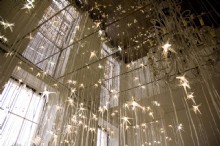
Renders Transparent What Was Once Concealed
LightHive, an installation by artist/architect Alex Haw :: Architectural Association :: until Saturday June 2, 2007.
LightHive occupies the entire main block - 5 addresses, 5 storeys and 160 rooms - of the institution's home in Bedford Square. A vast distributed network composed of various types of camera, infrared and wireless sensors relay back to a central exhibition space, where the communal activity of the school illuminates a scale model of its own light sources. Each light source is custom scripted and generated from the spatial and luminous parameters of its original source, and activated in real time by occupancy, contributing to an immersive form of spatial, 3-D surveillance. The installation renders transparent what was once concealed, compensating for the optical restrictions of the very object of the school's study: architecture.
Appearing as a spatial extension of the existing Front Members' Room's magnificent listed chandelier, its greater aim is as a self-documenting, self-recording architecture that is animated by people, resulting in a form of spatial video. It has several operational modes: predominantly realtime (which obediently varies between dynamic liveliness and patient placidity, with only intermittent signs of life), it is punctuated every half an hour by timelapse playback from its sensor database, followed by a series of fictional playbacks.
http://www.artshub.co.uk/view/ahrd.asp?Id=158989&ref=admin
http://www.kultureflash.net/current/#event4500
Posted by jo at 11:51 AM | Comments (0)
May 21, 2007
Rafael Lozano-Hemmer at La Biennale di Venezia
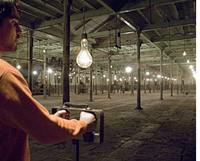
Pulse Room
Pulse Room, one hundred incandescent light bulbs controlled by the heartbeat of the public :: Mexican Pavilion at the 52nd International Art Exhibition – La Biennale di Venezia :: Press Preview: 7-9 June, 10 AM-8 PM :: Receptions: 7, 8 and 9 June, 8-10 PM :: Exhibition: 10 June–21 November, 2007 :: Palazzo Van Axel, beside the Chiesa dei Miracoli, Cannaregio 6099, Venice 30121 Italy :: +39-041-520-4807 .
Rafael Lozano-Hemmer represents Mexico at the 52nd Biennale di Venezia with the exhibition “Some Things Happen More Often Than All of the Time”, curated by Príamo Lozada and Bárbara Perea, a show which will mark Mexico’s first official participation in the Biennale. The exhibition will consist of 6 large-scale installations covering 1,000 square metres of the Palazzo Van Axel, a 15th-century gothic landmark bordering the Chiesa Santa Maria dei Miracoli, in the vicinity of the Rialto bridge.
Lozano-Hemmer (Mexico City, 1967) develops large-scale interactive installations combining the languages of architecture and performance art. His work uses technologies such as robotics, surveillance and telematic networks to create platforms for audience participation, creating "anti-monuments for alien agency". His large-scale light and shadow installations are inspired by animatronics, carnivals and phantasmagoria, situating the spectator as a fundamental component to “complete” the work.
“His work succeeds in giving the unchoreographed the power of a full orchestra..."-- CK Kuebel, NY Arts Magazine
Lozano-Hemmer’s work in kinetic sculpture, installation, video and photography has been shown in over thirty countries, including the Biennials of Sydney (Australia), Shanghai (China), Liverpool (United Kingdom), Istanbul (Turkey) and Havana (Cuba). His work is part of important private and public art collections such as those of the Museum of Modern Art in New York, La Colección Jumex in Mexico City, Fundación Cisneros Fontanals in Miami, the Daros Latin America Collection in Zürich and the Tate Collection in London.
The official participation of Mexico in Venice is the result of joint efforts by Secretaría de Relaciones Exteriores, Consejo Nacional para la Cultura y las Artes, Instituto Nacional de Bellas Artes, Consejo de Promoción Turística and the generous support of the Fundación/Colección Jumex and the Fundación BBVA Bancomer. The non-profit Patronato de Arte Contemporáneo, which has also contributed funding and resources, is in charge of the administration of the project. The receptions, starring DJ sets by Sonido Changorama, will feature sponsored drinks by Jumex, Tequila Cuervo and Cerveza Sol.
A bilingual catalogue will be published by Turner Libros, featuring essays by Manuel de Landa, José Luis Barrios, Barbara London, Cuauhtémoc Medina, Victor Stoichita and curators Príamo Lozada and Bárbara Perea.
Coinciding with the 52nd Biennale di Venezia, Lozano-Hemmer’s work will also be exhibited at Art Basel Unlimited, at the Luminato Festival in Toronto and in the exhibition “Automatic Update” at the Museum of Modern Art in New York.
Contact information:
Consejo Nacional para la Cultura y las Artes:
Plácido Pérez Cué, Director General de Comunicación Social
Tel. +52 555 662 1907
Fax +52 555 662 4314
pperzcue[at]correo.conaculta.gob.mx
Contact for Rafael Lozano-Hemmer:
Natalie Bouchard
Tel +1 514 597 0917
Fax +1 514 597 2092
natalie[at]antimodular.com
http://www.lozano-hemmer.com/
Contact for the curators:
Proyectos Hélix
Príamo Lozada and Bárbara Perea
+ 39 340 755 9584 in Venice
+ 52 555 207 6411 in Mexico
helix.curatorial[at]gmail.com
Rafael Lozano-Hemmer is represented by Galería OMR (Mexico City), bitforms gallery (New York) and Galerie Guy Bärtschi (Geneva).
Posted by jo at 03:28 PM | Comments (0)
May 11, 2007
Visual Voice Pro
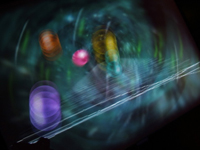
An Ultra-Responsive Environment
Visual Voice Pro creates an immersive, reactive digital playspace. The installation is comprised of a sensitive microphone, a computer with a data projector, and custom software written especially for the space. The microphone listens to all of the sounds in the room, from tiny footsteps to laughter to singing or even banging a drum. The computer instantly processes the sounds to create abstract, beautiful graphics. Action and re-action are clearly, vibrantly displayed. When the room is quiet, the scene falls still and dark. When there is noise there is activity. The louder the noise the bigger the effect.
"The entire experience has been designed based on requests from parents and care-givers of people with autism, cerebral palsy, and all sorts of behaviour disorders," says Adam Montandon, "So I am very keen to hear what anybody thinks."
Adam Montandon is the Director of HMC Interactive. You can contact him at Grosvenor House, Belgrave Lane, Plymouth, PL4 7DA, UK :: + 44 (0)845 20 11 462 :: Mob: + 44 (0)772 17 36 021.
Posted by jo at 09:46 AM | Comments (0)
April 26, 2007
RECONFIGURABLE HOUSE: HACKING LOW TECH ARCHITECTURE
By Usman HAQUE & Adam SOMLAI-FISCHER using sensors and actuators developed by the Reorient Team.
The Reconfigurable House is an environment constructed from low tech components that can be "rewired" by visitors. The project is a critique of "smart homes",which are based on the idea that technology should be invisible to prevent DIY. Smart homes actually aren't very smart simply because they are pre-wired according to algorithms and decisions made by designers of the systems, rather than the people who occupy the houses.
Posted by jo at 02:41 PM | Comments (0)
February 21, 2007
SplineGraft - Krets
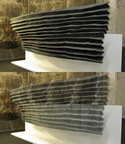
Controlled by a Genetic Algorithm
The SplineGraft project sets up a reactive environment in which sound dampening panels are continuously reshaped by a network of actuating devices, triggered by user movement. The panels are grafted into an existing environment, supported by structural racks allowing a range of different configurations. The SplineGraft can be set in different overall shapes independent of its behavior. The different parts are grafted onto each other; the profiled polyurethane panels are articulated by the configuration of the structural racks. The texture of this primary form is reshaped in real time by the control system integrated in the structural racks; a continuous form finding process with emergent patterning effects. In return, the spline ridges of the panels disperse these transformations horizontally.

Structure
The supporting structural racks are assembled from cnc-milled clear acrylic units, each integrating the actuating mechanisms, milled tracks for cabling and etched nickel brass conduits for inter-unit connectivity. The angle between each structural component can be set in five different positions, allowing the rack to be set at a convex or concave configuration, while maintaining conductive links between each part. Each rack of five units is controlled by a micro controller, steering the integrated actuators in the form of dual shape memory alloy wires. The central intelligence of each rack communicates with neighboring racks through radio.

SplineGraft behavior
The behaviour of the SplineGraft is controlled by a genetic algorithm; a computer program that simulates and compresses the geologically slow processes of natural selection to nanoseconds of computational time, in order to evolve solutions to specific problems. The Spline Graft algorithm is in this way trying to emit patterns of movement which stimulate occupation of the space it has been grafted in to. The matching of sensor readings and motor reactions in an apparently intentional way by the Spline Graft, transforms architecture into a cybernetic agent involved in the making and production of space.

SplineGraft materials
CNC-milled acrylic structural components with integrated wiring, machined polyurethane foam, etched nickel brass conductors, IR Movement Sensor, custom made PCB Cards, AVR Atmega8 Microcontrollers, Radio Modules, diverse electronic components, Flexinol® shape memory alloy actuators with protective Teflon tubes. SplineGraft was developed by Krets partners Pablo Miranda and Jonas Runberger. A full list of credits are available on the project website.
My thanks to Chris aka Pixelsumo for the tip. [blogged by Ruairi on Interactive Architecture dot Org]
Posted by jo at 12:51 PM | Comments (0)
February 13, 2007
Wake Up and Hide
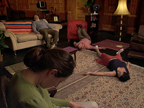
Art that Leaves
Art that leaves the room when you come in by Alastair Sooke; a review of Gary Stevens at Matt's Gallery, London, Telegraph.co.uk,/a>; In pictures: Gary Stevens at Matt's Gallery.
More often than not, works of art stay still. Not so the latest piece by British performance artist Gary Stevens. Wake Up and Hide, his two-screen video installation at Matt's Gallery in east London, is a fiendishly tricksy work that reacts to the viewer. When you walk into the gallery, you see a bunch of larger-than-life people silently staring at you from two almost identical oak-panelled interiors.
That in itself is fairly disconcerting, like wandering into a party to be confronted with a sudden, deathly hush. But it's nothing compared to what happens next. As soon as you make a noise – a cough, a footstep, a rustle - everyone on screen scarpers. On the left (Hide), five performers hurry to hide around the room: behind a bookcase, under the stripy sofa, wrapped up in a red plush curtain.
On the right (Wake Up ), another five leap up with cartoonish mannerisms – arms windmilling, grimacing expressions of exaggerated surprise – before sprinting out of shot like the slapstick Keystone Kops (Stevens's inspiration).
And that, believe me, is far, far more uncomfortable, like turning up at a party to find that your arrival prompts a rush for the door. People talk about portraits with eyes that follow you around the room, but I can't think of any work of art that actually leaves the room when you come in.
Stick around and stay quiet, though, and the 10 performers gradually return. In Hide, they re-emerge one by one, heads popping up from pieces of dark, heavy furniture like meerkats sniffing the wind for danger in an Attenborough doc.
In Wake Up, they come back looking tense, backs and necks ramrod-straight.
Then, if you do nothing, they start to unwind. In Hide, they gain confidence, venturing into the open, sizing each other up with sly, slanting looks. In Wake Up, their stiff postures begin to droop until, like melting snowmen, they seep on to the floor.
But make a noise, picked up by one of four sensitive microphones rigged up in the ceiling, and both videos jumpcut to another segment of film.
As before, one load of performers suddenly disappears around the room. The others vamoose. It's like playing peekaboo or grandmother's footsteps.
To create such a technical tour de force, Stevens uses tech-geek wizardry. Each time a sound triggers footage of the performers scurrying away, a computer selects one of five subtly different "narratives" tailored for both screens.
In one loop, a performer plays the piano; in the next, another starts to smoke.
Assuming you let them, of course. At first, Wake Up and Hide makes you feel unpopular: I tiptoed around to avoid disturbing the people on screen.
But as you figure out how the sound-sensitive installation works, you begin to clap or talk loudly so that the actors scramble at your beck and call. The piece provokes a strange, vaguely omnipotent rush.
That said, you can never get them to do exactly what you want. Which means that Wake Up and Hide functions as a witty satire of our interactive, press-the-red-button, you-decide-who-goes age.
In Stevens's world, we – the spectators – are blunderers, clumsily controlling the work only to disrupt it. If we send the performers skittering, we won't discover how the films unfold when left to play undisturbed.
And if we stay quiet so that the films unspool, then, really, the performers are the ones controlling us. It's a situation that would send Jade Goody's mind into meltdown. Until March 18. Information: 020 8983 1435
Posted by jo at 03:54 PM | Comments (0)
January 18, 2007
Schwelle
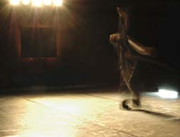
@ Tesla/Transmediale 2007
Schwelle is a new media and performance project using cutting edge acoustic and interactive technologies to explore the extreme threshold states of consciousness that constitute human experience. The multi-part project uses High Definition image and multi-channel sound, interactive installation and live performance to create states of consciousness in the spectator akin to the thresholds states that one experiences at the edge of trance, sleep and death. For transmediale '07, Tesla presents parts 1 and 2.
Part 1 is a turbulent exploration told by way of image and sound of the experience undergone at the time of the dissolution of the body and of consciousness. Part 2 is a live performance in which the audience confronts a lone single performer Michael Schumacher, master improviser and long time dancer by William Forsythe’s Frankfurt Ballet, experiencing the traumatic transition period between death and rebirth. Utilizing wireless sensor networks in the room and on the dancer’s body, Part 2 creates a stage environment where light, sound and objects take on their own choreography, performing with Schumacher, breathing, and behaving alongside him. Where does the body end and the room begin? What happens in the threshold where body and room merge, mutually influencing and transforming each other?
Schwelle is a co-production between artists and researchers from cultural and scientific institutions in Canada, China, Germany, Holland, China, and the USA. Schwelle, Part 2 was partially developed during a project residency at Tesla in Summer 2006 and will receive its world premiere at "tesla zur transmediale".
Part I
Concept/Direction/HD Video/Sound: Chris Salter
Collaboration Sound: Daniel Moody-Grigsby and Philip Viel
Part II
Premiere: Tesla/Transmediale 2007, Berlin, February 2007
Concept/Direction: Chris Salter, in collaboration with Michael Schumacher
Dramaturgy: Heidi Gilpin
Lighting Design: Lea Xiao
Sound Design and Programming: Marije Baalman, Daniel Moody- Grigsby, Chris
Salter, Philip Viel
Interaction Design/Sensing Systems: Marije Baalman
Objects: Thomas Spier, Flora Luna
Production Stage Manager/Technical Director: Daniel Plewe
Production Assistents: Daniel Wessolek, Alexander Wilson, Brett Bergmann
Tesla: Medien-Kunst-Labor, Klosterstrasse 68, Berlin
Thursday-Saturday, February 1-3, 2007. 20:30
For tickets/more information, please visit http://kasse@tesla-berlin.de
Christopher L. Salter, Ph.D.
Asst. Professor of Computation Arts
Faculty of Fine Arts
Concordia University
Researcher_Interactive Performance and Sound Hexagram
Posted by jo at 03:00 PM | Comments (0)
January 04, 2007
Mogens Jacobsen:
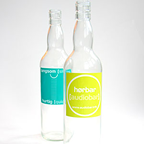
Hørbar/Audiobar
Hørbar/Audiobar is a responsive environment for natural and playful exploration of huge collection of audio art. You can interact with the sounds using a tangible interface based on RFID-tagged bottles. The environment consists of two rooms: A bar-room for shared interaction and a study lounge for more in deep explorations.
Hørbar/Audiobar will be premiered at the Museum for Contemporary Art in Roskilde, Denmark. This museum has a huge collection of international audio art which will be accessible at the bar. The installation is part of the exhibition Social_Action - The Audience and the New Media Landscape.
The exhibition opens on January 12th 2007 at 17:00 - 20:00 :: Address: Museet for Samtidskunst :: Stændertorvet 3D, DK-4000 Roskilde, Denmark. The project is supported by Kulturnet Denmark and Sound Forum Øresund.
Posted by jo at 06:12 PM | Comments (0)
December 15, 2006
Daan Roosegaarde talks about Dune 4.0

"Alice in Technoland"
Dune 4.0, developed by Daan Roosegaarde, is an interactive landscape which physically changes its appearance in accordance to human presence.
Placed in the main corridor of Montevideo (Amsterdam, NL), Dune 4.0 is composed of hundreds of fibers which react to the movements and sounds made by the visitors. This hybrid of nature and technology functions as a platform on which the relationship between visitor and the existing architecture is enhanced. By means of looking, walking and interacting, visitor and space merge into one coherent environment which could be best interpreted as a kind of "Alice in Technoland".
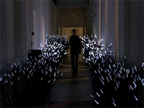
Dune 4.0 is currently further developed for a public site besides the river Maas in Rotterdam.
It's not the first time i mention Roosegaarde's projects. He has previously designed, among other projects, 4d pixel, a smart surface which physically reacts to your voice, music and can write relievo letters and Liquid 2.0, a living cocoon which physically reacts to your motion and sounds. This time i decided to ask him a few questions about his latest piece. More >> [blogged by Regine on we-make-money-not-art]
Posted by jo at 08:31 AM | Comments (0)
December 07, 2006
Volume

Sculpture that Reacts to Presence
On Friday night I went to the opening of Volume at the V&A Museum, part of the Playstation Season of Culture. Here are my photos.
UVA have now posted a video (waiting for new video)
Created by United Visual Artists and one point six (production company set up by Robert Del Naja [alias 3D] of Massive Attack and Neil Davidge) for the John Madejski Garden.
This is an immersive light and sound sculpture that reacts to presence. Interaction is based on proximity, so without any participants it lies dormant, waiting to be awoken.
Each column contains a matrix of multicoloured LEDs and a speaker. UVA use custom written camera tracking software to watch people moving through the space. As this photo explains, infrared lights are used to illuminate the area, whilst a high mounted camera looks down from above. I counted around 6 different scenes, each with a distinctive style (the video and photos show a few). The sound fitted perfectly, sometimes subtle, othertimes responding to your movements past each column. The garden is fantastic location for work like this, the water puddles creating reflection, shadows around the architecture changing and sounds travelling around the space. The colour gradient fades are beautiful, and the nicest part was the interlude between scenes. The lights slowly die down, then pulsate with white light and sound in anticipation for the next visitors.
On show until 28th Jan 2007. When visiting be prepared to wait in line, particular at peak hours, as only a certain number of people are able to experience the project at once (that was only the opening night).
Here are some gorgeous behind the scenes photos…
Related post: UVA at Transvision [posted by Chris OShea on Pixelsumo]
Posted by jo at 08:15 AM | Comments (0)
October 05, 2006
Christian Kerrigan

Growing a Hidden Architecture
CFhristian Kerrigan's project, Growing a Ship in a Yew Forest "explores the possibilities of a symbiotic relationship between two different systems of organization, technology and nature… to theoretically alter newly planted trees in the last remaining Yew forest."(Kingley Vale)
Architect & Editor of 'The Space Between'magazine, Christian Kerrigan investigates in his recent work, how man’s ability to control his surroundings is intimately linked with his advancing capabilities of using technology. Christian says "We have reached a point in our evolution where we are now capable of creating design criteria to manipulate natural growth and development."
By controlling the manipulation of refined armatures, calibrating devices and designed corsets; the system is capable of controlling the growth of a ship inside the forest. The ship will grow over a period of two hundred years and will exist as a hidden architecture inside the trees.
Posted by newradio at 10:06 AM | Comments (0)
Fred Guttfield
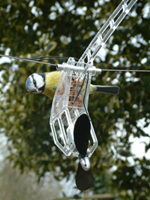
The Bird Table
Fred Guttfield ´s work explores the contested territory between technology and nature. He designs 'Natural Amplifiers' which highlight the necessity and beauty found in nature and natural behaviours. The Bird Table is his latest project. Fred explains: “The current garden bird feeder is a typical example of design in spite of nature. The bird feeder exhibits few natural characteristics but as a result of regular interaction with local birds begins to condition the birds to Pavlovian levels.' Using a combination of observation and parametric design methods the 'Bird Table' went through a number of iterations to behave not just in response to the birds that interacted with it but also to human and wider environmental factors. In this way the table has developed its own behaviours, moods and rhythms in tandem with the ecology in which it is sited.”
Posted by newradio at 09:55 AM | Comments (0)
September 11, 2006
ARUP Advanced Geometry Unit
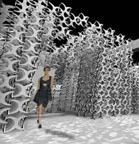
h-edge
ARUP Advanced Geometry Unit: h-edge :: September 14 to October 28, 2006 :: Opening Reception: September 14, 6-8PM.
This fall, Artists Space presents h-edge, a new project created by Cecil Balmond and ARUP Advanced Geometry Unit, a think tank dedicated to researching complex structural geometry in support of new architectural visions and solutions. AGU’s installation at Artists Space will function as an enclosure within the gallery, allowing visitors the opportunity to experience, interact with, and compartmentalize physical space in new and exciting ways. h-edge is an experiment in the use of geometry and matter to create organizations of space. h-edge traverses the boundaries of mathematics, art, architecture and engineering, exploring new opportunities of complexity.
The project exists on three levels: the mathematical-geometric, the architectural-spatial and the structural-tectonic. h-edge is based on a cubic fractal tiling of space known as the Menger Sponge. The geometric matrix of this sponge is modular and self-similar offering positive and negative space at embedded scales. This binary tiling is deployed at three different scales, which create spatial conditions that relate to the scale of the human body. These are named cave, trench, and path.
Tectonically, the tiling is achieved through the use of two modular units: the leaf and the chain-link, which interlock to form a suspended network of reciprocal load-paths. The staggering of the plates along the chain in four directions ensures that no plate touches another and that the chain is pre-stressed to form a rigid load-path. h-edge and the Fourier Carpet are binary systems describable as ordered series of 0 and 1 digits in three- and two-dimensional mathematical space. They both demonstrate how number systems can be used to describe, control and inform geometric complexity.
h-edge has been designed by the ARUP Advanced Geometry Unit in London, and constructed in Philadelphia with the help of Penn Design students. It consists of 5200 laser-cut aluminum plates and almost 5000ft of stainless steel chain. The Fourier Carpet has been digitally generated and designed by Jenny E. Sabin in Philadelphia and woven on a digitized Jacquard Loom by Keystone Weaving in Lebanon, Pennsylvania. It is 36ft by 5ft and is composed of interlaced black and white wool threads.
Design Team: Cecil Balmond, Charles Walker, Francis Archer, Daniel Bosia, Jenny E. Sabin
Assembly Team: Jenny E. Sabin and PennDesign Students
Curated by Christian Rattemeyer
h-edge is supported, in part, by ARUP, the Graham Foundation for Advanced Studies in the Fine Arts, Elise Jaffe + Jeffrey Brown, and PennDesign.
ARTISTS SPACE
38 Greene Street, 3rd Floor
New York, NY 10013
T 212 226 3970
F 212 966 1434
artspace[at]artistsspace.org
http://www.artistsspace.org
Posted by jo at 04:12 PM | Comments (0)
August 08, 2006
Responsive Environments:
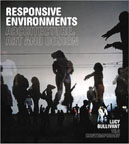
Architecture, Art and Design
Responsive Environments: Architecture, Art and Design by Lucy Bullivant :: Responsive environments - by definition spaces that interact with the people who use them, pass through them or by them - have in a very short space of time become ubiquitous. Not just confined to the fantasy worlds of films ... digital technology-enabled spaces, notoriously employing unprecedented levels of CCTV as well as demonstrating the seemingly infinite powers of multimedia, have invaded our lives, fundamentally affecting the identity of public, corporate, retail and cultural spaces, and connecting remote environments ...
Artistic manifestations of the use of digital technology in physical spaces are growing. Electronic billboards have been around for decades, but now the concept of connectivity has also literally seeped into the skins of buildings in new ways. Artists - and architects working in hybrid fields on interactive projects - are responding to the electro-physical flux of urban environments, coopting responsive dynamic media systems, wireless sensing, wearable computing and even topological media. They proactively consult scientific institutions to dig deeper into their environmental interests, and are not interested in 'tech' or smart spaces for the sake of it, but to create environments that act as mediating devices for a new social statement.
While IT applied purely commercially for applications and products always focuses on new technologies' speed and efficiency, the responsive projects featured in this book - many of them using low-tech elements - engage through experiment with our wishes and bodily sensations on an existential level. Our bodies are able to directly experience their environment in a very direct and personal way.
A number of young architects have chosen to create interactive spaces instead of designing and constructing buildings in a more traditional sense. Their interests now overlap strongly with those of designers and artists resulting in a shift in priorities which transcends objects, to reinvent design as more of an event-based installation concept - an approach that is of huge value now that the best museums, galleries and visitor attractions are striving to open up more participatory ways of engaging their publics.
Drawing on interviews by the author with the designers, architects and artists featured - including Jason Bruges, Lars Spuybroek, Scott Snibbe, Diller + Scofidio, Ben Rubin, Rafael Lozano Hemmer, David Small, Christian Moeller, Usman Haque, HeHe, Electronic Shadow, Shona Kitchen and Ben Hooker, Stefano Mirti and Walter April, Casson Mann, Golan Levin, Sponge (Chris Salter, Sha Xin Wei, Laura Farabo), Toyo Ito, UN Studio, Mark Goulthorpe, Toshio Iwai and KDa, Maywa Denki, Sociable Media Group (MIT), d-squared, Allofus, Kas Oosterhuis, Tobi Schneidler, Décosterd + Rahm, Realities:united, Adam Somlai-Fischer and Mette Ramsgard Thomsen - this unique account sheds fresh light on the way new technologies are being harnessed, amidst a cultural context of growing multidisciplinary activity in art, architecture and design during the last 15 years. [via]
Posted by jo at 01:31 PM | Comments (0)
July 20, 2006
Meta Morphic "Living" Architecture

Why can't architecture grow with us?
Digitally-aided technology can be imbedded in the creation of new, living systems. Recent advancements in the production of living materials and in the logic behind the kinetics of robots have brought both fields closer together, and have begun to blur the lines of what we think of as "living." Robots made of parts that can communicate with each other act the same as living materials, and should be considered "alive" because they can respond to changing information (conditions), much like living materials can.
Digital technology, and the mechanics that allow spaces to be kinetic, should be embedded in the physical architecture we live in. The form of Architecture should not be predetermined, instead Architecture should play a more active role in suggesting new ways for its inhabitants to use space based on real time information exchanges. Recently, technological advancements have been made in robotic fields that look at new ways of designing systems to be more interactive. We should employ this way of thinking when we design the relationships of the parts that make up interactive space. Spaces should be constructed of parts that have the ability to communicate with one another and constantly reshape our experience. -- Robert Miles Kemp [via Interactive Architecture]
Posted by jo at 09:54 AM | Comments (0)
July 06, 2006
Angels
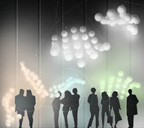
Constructing Reconfigurable Space
As a continuation of (Ruairi Glynn's) research into physically reconfigurable interactive architecture, the Angel project which I collaborated on with Paul Burres (Bartlett, UCL) investigates ways of constructing intelligent agents that can work as independent spatial features or combine to assemble virtually infinite constructs. The ‘Angel' project questions the nature of fixed architecture and looks at the possibilities of an architecture lighter than air capable of sheltering us and even bringing communities together.
The first built iteration of these ‘Angels' has been given a simple set of behaviors reacting to human gesture, proximity and conversation, future iterations will investigate learning algorithms so that the Angels can adapt to their environment. In its current form the “Angels” act as individuals but the potential for these to structurally network is a continuing part of our investigation.

Development: The initial concept developed from a building study in which we created a conversation space that could transform its spatial conditions reacting to a set of protocols based on inhabitant’s discourse. The constantly reconfiguring space was actuated by a series of agents that could descend, rise, approach and retreat from the people within the space as well as articulating a range of behaviors “Gestures” in an attempt to act as catalysts for the generation of new conversation and interaction...
Video. Project Summary PDF (1.6Mb); Details of Project Development PDF (3.3Mb); [via Interactive Architecture]
Posted by jo at 07:20 PM | Comments (0)
July 04, 2006
Architecture and Situated Technologies
![]()
Pre-Symposium Discussion
A three-month long discussion will prepare the Architecture and Situated Technologies symposium in October 2006. Contribute or follow the discussion. This symposium is a coproduction between the Center for Virtual Architecture at the University at Buffalo, The Institute for Distributed Creativity, and the Architectural League of New York.
Introduction: The Architecture and Situated Technologies symposium, organized around the notion of an "encounter," will articulate new research vectors, sites of practice, and working methods for the confluence of architecture, art, and situated technologies.
What opportunities and dilemmas does a world of networked objects and spaces pose for architecture, art, and computing? How might this evolving relation between people and "things" alter the way we occupy, navigate, and inhabit the built environment? What is the status of the material object and the embodied human relationships in a world privileging networked relations between "things"? How do distinctions between space and place change within networked media ecologies? What post-optimal design strategies and tactics might we propose for an age of responsive environments, smart materials, embodied interaction, and participatory networks?
While there is an explosive growth of mobile devices, the social uses of technologies are not sufficiently studied in terms of architecture. What distinguishes the emerging urban sociality enabled by the Wireless Internet? How do these dynamics, including (non-)affective giving destabilize rationalized 'use case scenarios'?
These are just a few urgent questions that the symposium will raise.
Through a combination of public and closed segments (workshops, presentations, and panel discussions), the symposium will stage a set of encounters between invited participants, an audience encouraged to participate, and the City of New York.
List facilitators:
July: Trebor Scholz
Topics: Networked Public Sphere, Autonomous Uses of Situated Sociable Media
August: Omar Khan
Topics: Performance Paradigms, Responsive Architecture and Artificial Ecologies
September: Mark Shepard
Topics: Locative Media, Tactical Urbanism, Situated Aesthetics
Posted by jo at 11:39 AM | Comments (0)
June 28, 2006
TRG [Transreality Generators]
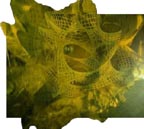
The 'Irreal' in New Media Art
TRG [Transreality Generators]--by FoAM--is a project that builds upon the two previous immersive installations / responsive environments: TGarden and txOom. All three projects are concerned with the 'irreal' in new media art. By 'irreal' we mean artworks that provoke a tension or imbalance between tangible reality and the imaginary worlds. With responsive environments, the line between the real and the imaginary can be very thin, allowing for the experience to become 'irreal' - where the participants fade in and out of physical reality, uncertain of their position in this 'reality continuum'. TGarden was designed to allow human gestures to use video and audio as calligraphic media, to 'write and draw' the immersive environment on the fly. txOom extended the concept and became an 'irreal ecology' where media would grow based on their interaction with the participants. TRG changes scale once more, to infinitely large and infinitely small 'irreal universes', whose existence is highly unstable and unpredictable, where minuscule local interactions can conjure up the lives massive worlds.
The conceptual framework within which the artists develop their concepts and designs is 'simulation of physics and physicality of simulation'. In order to be able to 'mix' the physical and the virtual reality in interesting ways, the artists explore the basic principles that constitute our universe (gravity, electromagnetism, nuclear forces) and create media worlds as new universes, where physical laws become amplified, distorted, enlarged etc. To the audience immersed in the MR environment, these worlds should 'feel' as familiar and intuitive, but upon closer inspection their strange and magical properties can become apparent. The TRG team creates rich media worlds consisting of materials, objects, interfaces and architectures that allow a seamless transition between the physical reality and the computational worlds. By correlating some of the more interesting properties in the physical systems (such as fundamental physical forces, string theory and membrane physics, tensegrity principles, etc.), and abstracting them, there is the potential to create new (coherent) laws within the media-worlds.
The project focuses on Mixed Reality (environments containing significant virtual and physical interaction possibilities, strongly intertwined) and exploring its implications in the cultural sphere. Mixed Reality (MR) enables the public to be immersed in multisensory, responsive media environments capable of reacting and evolving, influenced by human activity and interaction. The participants leave the role of the observers and become creators of a temporary autonomous reality. In TRG, an international team of artists and technologists explore the frontiers of this unique form of creative expression through the integration of self-contained systems of media, materials and structures, perceived as a distinct field of reality, embedded in the physical objects and architecture. This project examines the potential to extend their artistic practice into the field of situational experience design, in which the art-works become all-encompassing art-worlds. [Related]
Posted by jo at 06:28 PM | Comments (0)
June 23, 2006
Smoke Signals

Writing Space and Memory Clouds
June 24, 2006 at 9:28 p.m. (GMT): Smoke Signals--by Minimaforms--is based on one of the oldest forms of communication in recorded history dating back over 5,000 years. The project works as a hybrid system that explores the dynamic and spatial capacities of smoke and light in relation to contemporary mobile SMS technologies of messaging today. Smoke Signals examines a dynamic real-time interaction that writes space. Smoke and light setup the condition for developing a typographic ambient / responsive environment.
Participants are invited to communicate with the project by sending SMS messages to one of two smoke signals located at the event. Remote participants can send messages through our Real-Time Virtual Interface located at memorycloud.com
Minimaforms was founded in 2002 by brothers Stephen and Theodore Spyropoulos as an experimental design practice that explores design that provokes and facilitates new means of communication. Also see www.fasterthansound.com.
Posted by jo at 03:17 PM | Comments (0)
June 22, 2006
Implant Matrix
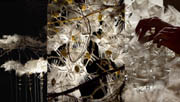
An Empathic Matrix
Implant Matrix is an interactive geotextile that could be used for reinforcing landscapes and buildings of the future. The matrix is capable of mechanical empathy. A network of mechanisms react to human occupants as erotic prey. The structure responds to human presence with subtle grasping and sucking motions, ingesting organic materials and incorporating them into a new hybrid entity.
Implant Matrix is composed of interlinking filtering 'pores' within a lightweight structural system. Primitive interactive systems employ capacitance sensors, shape-memory alloy wire actuators and distributed microprocessors. The matrix is fabricated by laser cutting direct from digital models.
By Philip Beesley and Will Elsworthy with Robert Gorbet and Steven Wood. Assistant Designers: Eric Bury, Liana Bresler, Miriam Ho, Desmond Shum. At Interaccess Gallery June 1-29, 2006.
Posted by jo at 04:30 PM | Comments (0)
June 13, 2006
Phillipe Rahm: Architect

Corporeal Space, Transmitting Bodies
REVERSE is a project dealing with a specialist inversion: the loss of information instead of receiving it. Its objective is to create spaces where data is lost where information diminishes, inverting the present-day system where data is distributed through electromagnetic projections in the cinema, on television and public announcements. In each case, the objective is not to receive information but to lose it, changing our state as receivers of information into that of transmitters of information. We estimate that the amount of information that we receive from our environment through our senses as being 10 bits to the power of 9.
REVERSE is an architectural and urban project that aims to produce negative information and a negative information environment--at least 10 raised to the power of -9. The field of action is the same: electromagnetic space, now however, the direction is reversed. Our bodies change from being to receivers to transmitters.
The infra-red beam directed to the cinema screen becomes cold and black. All bodies emit energy in the form of electromagnetic radiation. Our skin, at a temperature of between 33º and 36ºC emits infra-red radiation. If an object in our environment is colder than our skin, the heat our bodies lose in the form of radiation will be directed towards this colder object. Our body, placed before the screen becomes literally a projector of invisible information. This is the inverse state that we seek: changing from a passive to an active state, we become transmitters in a suddenly receptive environment.

Expo 01: A certain quantity of energy: our proposal for the Neuchâtel Arteplage [artbeach] at the 2001 Swiss National Exposition is designed to act solely on the quality of the air, as an architectural act performed on the raw material of architecture, which is space. Thus, there is no longer any recourse to shape, image, volume or surface. The aim is to work on the air itself, to alter its chemical characteristics and bring about a change in the physiological relationships between the human body and the environment.
Thus, architecture ceases to be a composition or opposition of heterogeneous elements such as figure and background, shape and surface, filled space and void, but becomes an internal change in what constitutes space, i.e., air as a physical medium. Space, improperly described as a vacuum, is recognized in its corporeality. The result is a reconquest of space as a quantity of air and air as matter, with its weight, density and physical and chemical characteristics, in which the human body is immersed.
Philippe Rahm (1967) studies at the Polytechnic school of Lausanne and Zurich. He obtained his architectural diploma in 1993. He was associated until 2004 with Jean-Gilles Décosterd into the Architects Office "Décosterd & Rahm, associés". He works currently in Lausanne ( Switzerland ) and in Paris ( France ). In 2002, he was chosen to represent Switzerland at the 8th Biennial of Architecture in Venice. He has participating in a number of exhibitions worldwide (Archilab 2000, SF-MoMA 2001, Museum of Modern Art of the City of Paris 2001, Tirana Biennial 2001, Valencia Biennial 2003; Lisbon Biennial 2003, Graz Biennial 2003; CCA Kitakyushu 2004, Mori art museum 2005, Frac centre, Orléans, Centre Pompidou, Beaubourg 2003-2005) Philippe Rahm stayed at the Villa Medici in Rome (2000. He is Master of the Diploma Unit 13 at the AA School in London, professor at ECAL Lausanne, visiting professor at the Ecole Nationale Supérieure de Beaux-Arts of Paris in 2003, Mendrisio Academy of Architecture in Switzerland in 2005. He is currently working on several private and public projects like a house for artist Fabrice Hybert (France), a new restaurant for the ENSBA in Paris, an urban planning for the Vassivière area in France, and a Park in Austria.
Posted by jo at 11:26 AM | Comments (0)
Phillipe Rahm: Architect

Corporeal Space, Transmitting Bodies
REVERSE is a project dealing with a specialist inversion: the loss of information instead of receiving it. Its objective is to create spaces where data is lost where information diminishes, inverting the present-day system where data is distributed through electromagnetic projections in the cinema, on television and public announcements. In each case, the objective is not to receive information but to lose it, changing our state as receivers of information into that of transmitters of information. We estimate that the amount of information that we receive from our environment through our senses as being 10 bits to the power of 9.
REVERSE is an architectural and urban project that aims to produce negative information and a negative information environment--at least 10 raised to the power of -9. The field of action is the same: electromagnetic space, now however, the direction is reversed. Our bodies change from being to receivers to transmitters.
The infra-red beam directed to the cinema screen becomes cold and black. All bodies emit energy in the form of electromagnetic radiation. Our skin, at a temperature of between 33º and 36ºC emits infra-red radiation. If an object in our environment is colder than our skin, the heat our bodies lose in the form of radiation will be directed towards this colder object. Our body, placed before the screen becomes literally a projector of invisible information. This is the inverse state that we seek: changing from a passive to an active state, we become transmitters in a suddenly receptive environment.

Expo 01: A certain quantity of energy: our proposal for the Neuchâtel Arteplage [artbeach] at the 2001 Swiss National Exposition is designed to act solely on the quality of the air, as an architectural act performed on the raw material of architecture, which is space. Thus, there is no longer any recourse to shape, image, volume or surface. The aim is to work on the air itself, to alter its chemical characteristics and bring about a change in the physiological relationships between the human body and the environment.
Thus, architecture ceases to be a composition or opposition of heterogeneous elements such as figure and background, shape and surface, filled space and void, but becomes an internal change in what constitutes space, i.e., air as a physical medium. Space, improperly described as a vacuum, is recognized in its corporeality. The result is a reconquest of space as a quantity of air and air as matter, with its weight, density and physical and chemical characteristics, in which the human body is immersed.
Philippe Rahm (1967) studies at the Polytechnic school of Lausanne and Zurich. He obtained his architectural diploma in 1993. He was associated until 2004 with Jean-Gilles Décosterd into the Architects Office "Décosterd & Rahm, associés". He works currently in Lausanne ( Switzerland ) and in Paris ( France ). In 2002, he was chosen to represent Switzerland at the 8th Biennial of Architecture in Venice. He has participating in a number of exhibitions worldwide (Archilab 2000, SF-MoMA 2001, Museum of Modern Art of the City of Paris 2001, Tirana Biennial 2001, Valencia Biennial 2003; Lisbon Biennial 2003, Graz Biennial 2003; CCA Kitakyushu 2004, Mori art museum 2005, Frac centre, Orléans, Centre Pompidou, Beaubourg 2003-2005) Philippe Rahm stayed at the Villa Medici in Rome (2000. He is Master of the Diploma Unit 13 at the AA School in London, professor at ECAL Lausanne, visiting professor at the Ecole Nationale Supérieure de Beaux-Arts of Paris in 2003, Mendrisio Academy of Architecture in Switzerland in 2005. He is currently working on several private and public projects like a house for artist Fabrice Hybert (France), a new restaurant for the ENSBA in Paris, an urban planning for the Vassivière area in France, and a Park in Austria.
Posted by jo at 11:26 AM | Comments (0)
June 05, 2006
Evolving Sonic Environment

Room to Develop "Perception" of its Occupancy
Evolving Sonic Environment -- Usman Haque with Robert Davis, Psychology Department, Goldsmiths College, London -- consists of two embodiments: a society of sonic devices distributed in a room and a mechanism for recording and reviewing the history of the population. It is hoped that the collective behaviours of the devices will be affected by the way that the room is occupied (by people or other mobile objects) and, as such, the room will develop a "perception" of its occupancy. One might say that the society of devices together function as a "people sensor", though there are no "people sensing" functions built into the individual devices.
Drawing on the work of Gordon Pask, Donald Hebb and Andrew Adamatzky, the project is an architectural experiment to investigate how one might construct an interactive environment that builds up an internal representation of its occupants through a network of autonomous but communicative sensors. [Read more >>]
Posted by jo at 05:03 PM | Comments (0)
May 26, 2006
Poker Club, Scotland
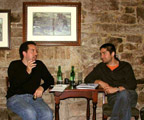
Haque + Bleecker
The Poker Club at the Beehive Inn in Edinburgh featured Usman Haque (artist / architect) and Julian Bleecker (technologist / artist / think tank leader) to discuss the "internet of things" and "open source architecture". Hosted by New Media Scotland.
Both presenters took us through a short run down of their work and then there was a lively exchange between everyone present. Hopefully there will be a podcast from New Media Scotland in the near future.
Haque's presentation was broken into three categories: Invisible Stuff, Collaborative Stuff (produced by non experts - or vernacular creativity) and Social Space. He talked about Architecture as an operating system for the collaborative production of space. He stressed the importance of the necessity of the system (whether an augmented object or space) to have the capacity to build 'its' own perceptual categories. Several examples of previous and current work were shown.
Bleecker started with the question 'Is life hackable?' He characterised the upsurge of activity as a renewed or second order humanism. The term 'change agents' was used and it was pointed out that these are no longer well positioned parties such as New York Times reporters. Several projects were shown which showed how digital networks can shape physical activities in a sort of network practice - social practice continuum. It was stressed that we're not just talking about data transactions.
Some interesting points that came up in the discussion:
:: We are surrounded by invisible information, how do we make this visible or legible?
:: Technology extends the zone of our perception/agency.
::Is the web of objects the end of subjectivity or a new beginning for subjectivity?
:: The role of human beings as filters.
The issues emerging for me are what do we mean by 'understanding' in relation to all the information we have access to and how do we have agency within it? One thing that came up over and over was the spatial or prepositional nature of our relationship to the digital networked public. As Bleeker points out in Why Things Matter are we 'on' or 'in' the network?
[posted by John Marshall on Designed Objects]
Posted by jo at 12:22 PM | Comments (0)
May 19, 2006
Chocolate Infinity
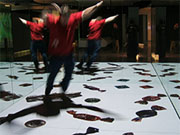
Chocolate Experience for Cadbury
Chocolate Infinity is a project from the HMC MediaLab for Cadburys Chocolate Factory. It’s carried out by Adam Montandon and HMC members. It interestingly used a shock sensitive floor and a series of motion sensors to immerse people in an intriguing interaction (to improve the visitors’ experience):
As you enter the infinity room a giant chocolate bar melts into gloopy puddles beneath you and, when you jump in them, chocolate splashes all over the floor. Then a sprinkling of individual Roses chocolates appear beneath your feet. You won’t believe your eyes when they unwrap as you tread on them – but as you step off they wrap back up.
Chunks of chocolate then fill the floor and when you stamp on them they break open showing gooey caramel, squidgy turkish delight, chunks of mint, orange or Cadbury’s Crunchie inside. Finally you get to chase three Creme Eggs across the floor but don’t stand still because they’ll pop their tops and taunt you until the game is on again.
Why do I blog this? this is one of the trends in roomware: using floor/sensor-based interactions to trigger specific behaviors. I see more and more project about that and I am wondering about potential new places that would allow people to play games with this settings (arcades revival?). [blogged by nicolas on pasta and vinegar]
Posted by jo at 05:26 PM | Comments (0)
12m4s reactive public display
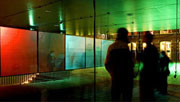
Combines Projection & Reflection
A visual & architectural intervention, tracking the movements of visitors in real time via image recognition & ultra sound sensors. The main parameters, such as position, orientation & speed are translated visually (in dynamic 3d particles) & sonically (through granular synthesis). The result is a "complex particle synthesis" that is projected on a semi-transparent mirror that combines projection & reflection, so that a common space between the digital & the physical world emerges. see also interactive waterfall. [lab-au.com|via interactivearchitecture.org] [blogged on information aesthetics]
Posted by jo at 07:41 AM | Comments (0)
May 05, 2006
Hyperbody Research Group
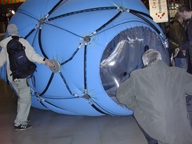
A place like a Muscle
I am really enjoying this Muscle NSA project carried out at the Hyperbody Research Group at Delft University. This is a programmable building that can reconfigure itself.
For the exhibition Non-Standard Architecture ONL and HRG realized a working prototype of the Trans-ports project, called the MUSCLE. (…) Programmable buildings change shape by contracting and relaxing industrial muscles. The MUSCLE programmable building is a pressurized soft volume wrapped in a mesh of tensile muscles, which change length, height and width by varying the pressure pumped into the muscle.
What is interesting is the interaction they designed engaging people in a playful activity:
Visitors of the Architectures Non Standard exhibition play a collective game to explore the different states of the MUSCLE.
The public interacts with the MUSCLE by entering the interactivated sensorial space surrounding the prototype. This invisible component of the installation is implemented as a sensor field created by a collection of sensors. The sensors create a set of distinct shapes in space that, although invisible to the human eye, can be monitored and can yield information to the building body. The body senses the activities of the people and interacts with the players in a multimodal way. The public discovers within minutes how the MUSCLE behaves on their actions, and soon after they start finding a goal in the play. The outcome of this interaction however is unpredictable, since the MUSCLE is programmed to have a will of its own. It is pro-active rather then responsive and obedient. The programmable body is played by its users.
There is also a slight connection with the blogject concept:
For the behavioral system this means that the produced sensorial data is analyzed in real-time and acts as the parameters for pre-programmed algorithms and user-driven interferences in the defined scripts. These author-defined behavioral operations are instantly computed, resulting in a diversity of e-motive behaviors that are experienced as changes in the physical shape of the active structure and the generation of an active immersive soundscape. The MUSCLE really is an interactive input-output device, a playstation augmenting itself through time.
Why do I blog this? what I like in this project is that it mixes different aspects of the HCI world: games, games software, architecture, usage of sensors. In the end, the outcome is pretty original and the visitors’ experience seem to be intriguing. I also like how it modifies the relationship of the visitors to a dynamic place. [blogged by nicolas on pasta and vinegar]
Posted by jo at 08:40 AM | Comments (0)
May 01, 2006
Bion + Lattice Archipelogics
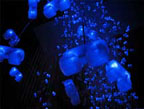
Responsive Fields
Bion is a robotic sculpture that explores the relationship between humans and artificial life. The name makes reference to an individual element of primordial biological energy identified as orgone by Wilhelm Reich. The installation is a sensor network that is composed of 1000 glowing and chirping forms. Each bion is a synthetic "life-form" consisting of a tiny computer, an audio speaker, blue LEDs, and sensors.
As a visitor approaches the installation space, one of the bions is alerted and quickly communicates the presence of a stranger to the swarm of bions. One by one, in rapid succession, the bions signal other bions of the intruder and, in a wave-like pattern, become silent. The bions eventually become accustomed to the visitor's presence and begin to respond to her/him as if s/he was part of their ecosystem. They become attracted to her and glow more intensely when she nears. Eventually, s/he is incorporated into the dynamic array. Video. By Adam Brown and Andrew H. Fagg, University of Oklahoma.
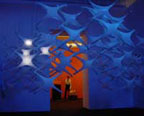
Another responsive field: Lattice archipelogics.
Distributed "sensitive" modules are reacting on the proximity of people approaching and entering the hybrid field of the lattice, translating the motion of individuals into ambient spatial patterns into light and sound.
Inhabitants turn into visitors, users or even actors in these new spatial scenarios, which is spelling another shift in defining architecture as a form of shaping environments.
Designed by Servo and Smart Studio/Interactive Institute. Images from Toby Schneidler's website. [blogged by Regine on we-make-money-not-art]
Posted by jo at 05:24 PM | Comments (0)
March 14, 2006
UVA Untitled LED Sculpture

Transvision Night
One of my favorite pieces from the transvision night was a responsive LED sculpture by United Visual Artists. Installed in the John Madejski Garden, from afar looked like people worshiping the arrival of an alien spaceship, whilst up close you could feel the warmth of all those LEDs. As you approached it, custom camera tracking software detected your presence and reacted by changing the visuals and booming out some granular synthesis sounds through the large speakers. This project created a great atmosphere in the garden and had an aura about it. For a better explanation, watch the video. More information. [blogged by Chris OShea on Pixelsumo]
Posted by jo at 08:30 AM | Comments (0)
March 09, 2006
Living Skins:
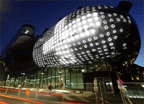
Architecture as Interface
"Buildings communicate their function and status through a language of visual signs… What if a sign did not simply tout new movies, sodas, and celebrity babies in one-way feeds, but instead revealed something unique about the building, its occupants, or its environment? What if the building could respond, in real time, to the movement of people, the weather, or the whims of bystanders or behind-the-scenes artists? Digital designers and architects have begun working together to move beyond the facade and give buildings a living skin." From Living Skins: Architecture as Interface by Peter Hall. [blogged by Ruairi on Interactive Architecture dot Org]
Peter Hall is Senior Editor and Fellow at the Design Institute, where he edits the Knowledge Circuit and is co-editor of the DI's second book, Else/Where: Mapping, (University of Minnesota Design Institute, 2006). Peter is a contributing writer for Metropolis magazine and has been teaching a seminar class on design theory and writing at Yale University since 2000. He lives in Brooklyn, New York.
Posted by jo at 12:52 PM | Comments (0)
February 02, 2006
The Snow Show 2006
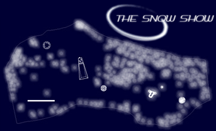
Bridging Art and Architecture
The Snow Show explores the issues related to Art and Architectural investigation by creating works from the ephemeral materials of snow and ice. An artist was partnered with an architect and invited to develop a work together—this conversation created a bridged between the art and architectural worlds. The teamed participants include Kiki Smith and Lebbeus Woods, Yoko Ono and Arata Isozaki, Carsten Höller and Williams & Tsien, Daniel Buren and Patrick Bouchain, Paola Pivi and Cliostraat, Jaume Plensa and Norman Foster.
Where are you by Jaume Plensa and Norman Foster: The white austerity of snow transforms the landscape profoundly. Like in a desert of sand, snow eliminates whatever narrative element there might be in the landscape, to give us the soul of the place in all its purity. GPS technology can give us our precise geographical position, a location in motion. This new form of portrait (of the landscape as much as the body) is, like snow, a metaphor of the ephemeral.
Conceived in 2000 by independent curator Lance Fung, The Snow Show has since constructed seventeen structures that furthered the discussion of interdisciplinary collaboration and set the tone for the current Snow Show. This year, the artists and architects have created interactive experiences inspired by the dramatic natural beauty of Sestriere and the athletic competitions of the Olympics.
03 February - 19 March 2006.
Sestriere, Turin
Posted by jo at 01:43 PM | Comments (0)
January 30, 2006
NEVEL
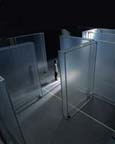
Moving Labyrinth at ARTEFACT
NEVEL, by Lawrence Malstaf, is a moving labyrinth (11 X 11 m) consisting of 9 programmable walls able to rotate 360° and react to the presence of the visitors, determining their route. Architecture comes alive, walls become doors, spaces open and close, visitors are locked up, desoriented and set free again.
Performers, visitors and their shadow are part of a tablaux vivant set for each other. The space itself is turned into an actor in the performance. An abstract place in to go astray like in a mutating city.
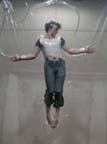
During the ARTEFACT festival that runs from February 13 till 18 in Leuven (Belgium), four artists / scientists will get to work with or within NEVEL and create new presentation forms and performances. For the festival, artists and scientists will research space, place & distance and translate it into new forms.
There's more about Malstaf and his works (which include curiosities such as Shrink, a 1995 installation inviting visitors to be vacuum-packed in plastic, with only an air bubble through which to breathe, picture on the right) in kopenhagen.dk and Frame magazine. [blogged by Regine on we-make-money-not-art]
Posted by jo at 08:34 AM | Comments (0)
January 12, 2006
The Fashion of Architecture

CONSTRUCTING the Architecture of Fashion
The Fashion of Architecture: CONSTRUCTING the Architecture of Fashion--
Galleries: Judith and Walter Hunt Gallery, Mezzanine Gallery, Kohn Pedersen Fox Gallery, HLW Gallery, South Gallery; January 11–March 11, 2006
Architecture is making its presence felt in fashion as the pliable metals, membrane structures, lightweight glasses and flexible plastics used in building construction are creeping on to the catwalks. At the same time, architects and interior designers are borrowing the techniques of pleating and draping from traditional tailoring to design buildings that are interactive, inflatable, and even portable. Works by practitioners such as Zaha Hadid, Winka Dubbeldam, Shigeru Ban, Kivi Sotamaa, David Adjaye, Block Architecture, 6a Architects, Lars Spuybroek, Stuart Veech and Meejin Yoon are showcased alongside architectonic apparel from fashion mavericks such as Martin Margiela, Hussein Chalayan, Yoshiki Hishinuma, Yeohlee, Pia Myrvold, Yohji Yamamoto, Boudicca, Eley Kishimoto, Kei Kagami, Michiko Koshino, Stéphanie Coudert, Simon Thorogood, Nicola de Main, and Arkadius. The exhibition features a special installation from Paris-based artist Lucy Orta.
Curator: Bradley Quinn, FRSA, a British author and critic based in New York. [posted by Regine on 21f]
Posted by jo at 05:53 PM | Comments (0)
January 11, 2006
Physical Markup Language
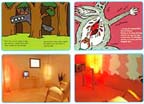
Your Room as Browser
Ambient Intelligence, with its network of cooperating devices, offers the promise of providing us with exciting new experiences in the home...An Ambient Intelligence system can interpret a description in Physical Markup Language (PML)--developed by Philips to describe experiences within an Ambient Intelligence environment. Devices in a network can jointly use their individual capabilities to render that experience at a given location.
In effect, your whole room becomes a 'browser' that brings the experience to life. For example, PML-enabled lights add to the experience by getting brighter or dimmer, or changing colour. A PML-enabled hi-fi provides an appropriate soundscape. Almost any device can be PML-enabled: the possibilities are only limited by the imaginations of their manufacturers. Suppose a room is rendering an experience described as 'warm and sunny': the lights, the TV, the central heating, the electronically controlled blinds and (a little further into the future) even the ceiling, walls and floor coverings could all contribute to creating it. [via nicolas at pasta and vinegar]
Posted by jo at 08:04 AM | Comments (0)
January 02, 2006
Transforming Digital Architecture from Virtual to Neuro:

An Interview with Brian Massumi
"The introduction of digital techniques into architecture, and the preoccupation with the virtual that came with it, brought up some very old questions with a new intensity. The change came at a time when the idea of "virtual reality" was very current in popular culture and had a major presence in the mass media. "Virtual reality" was used as a synonym for "artificial reality." There was something of an apocalyptic tone to many commentaries, to the effect that the new generation of digital technology was creating a technological cocoon around human beings that would separate them from any direct access to the world, and would denature human relations.
...Digital techniques in architecture added a new twist that changed the terms in which this question could be asked. This is because the software put into use by innovative architects such as Greg Lynn was evolutionary rather than representational. Rather than using traditional CAD software, where basic geometrical forms are reproduced and then modified or rearranged, architects employed special effects software...So you begin by programming forces rather than forms...[B]ecause of the complexity of the system, you can't predict exactly what the outcome will be." -- Brian Massumi, Transforming Digital Architecture from Virtual to Neuro: An Interview with Brian Massumi by Thomas Markussen & Thomas Birch, Intelligent Agent, Vol 5 #2.
Posted by jo at 04:25 PM | Comments (0)
December 16, 2005
Lacuna
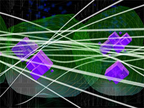
In the 'gap' Between Physical and Electronic Volume
Lacuna is a response to the relationship between body and architecture in the cyborg era. Existing in the perceived 'gap' between physical volume and electronic volume, Lacuna is customised software that communicates between the visual medium of the screen and a high resolution electronic skin of real world architecture. This in turn creates virtual counterpart architecture, enhancing the electronic Cybrid dimension of construction.
Lacuna--by HMC MediaLab--is a new architectural experiment that allows physical architecture to extend itself into the realm of zero physicality to become a Hyperflexible Space. Movement, temperature, gasses, wind, sound, data, water usage, electrical information, fans, and lift position are among a few of the hundreds of sensors used to alter the Lacuna software in real-time, allowing a unique representation of the building not in traditional space and time or virtual electronic space, but somewhere between the two.
Visitors to Plymouth's unique Portland Square building interact not through the key-press, or mouse-click associated with computing, but their very presence, or lack of presence, and usage of the building is converted into electronic signals. This, for the first time, allows visitors to exist simultaneously in the real and the virtual, they are everywhere and nowhere. Lacuna is in a constant state of flux, and intelligently updates, modifies and mutates itself many times a second.
Posted by jo at 03:37 PM | Comments (0)
December 13, 2005
Intelligent Environments [IE]
![]()
Intrinsically Motivated Rooms
"Abstract. Intelligent rooms are responsive environments in which human activities are monitored and responses are generated to facilitate these activities. Research and development on intelligent rooms currently focuses on the integration of multiple sensor devices with pre-programmed responses to specific triggers. Developments in intelligent agents towards intrinsically motivated learning agents can be integrated with the concept of an intelligent room. The resulting model focuses developments in intelligent rooms on a characteristic reasoning process that uses motivation to guide action and learning. Using a motivated learning agent model as the basis for an intelligent room opens up the possibility of intelligent environments being able to adapt both to people’s changing usage patterns and to the addition of new capabilities, via the addition of new sensors and effectors, with relatively little need for reconfiguration by humans." From Intrinsically Motivated Intelligent Rooms by Owen Macindoe and Mary Lou Maher, School of Information Technologies, Faculty of Architecture, University of Sydney, Australia.
Posted by jo at 12:00 PM | Comments (0)
November 18, 2005
MuscleBody
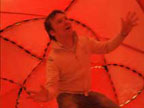
Translucent Skins
The MuscleBody is a full-scale prototype of an interior space. Its continuous skin incorporates all its architectural properties and makes no categorical distinctions such as floor, wall, ceiling, door. The interaction between the MuscleBody and its players (the people that have entered the interior space) causes the MuscleBody to change its shape, its degrees of transparency and the sound that it generates.
The structure of the MuscleBody is based on a spiralling tube that is bent in 3D. 26 industrial Festo muscles control the movement of the MuscleBody. The skin is made of Lycra, and its translucency depends on the degree of stretching. Speakers integrated into the skin generate sound samples that are combined and transformed according to the behaviour of the players.
The game starts when from the moment the visitor enters the MuscleBody. Information is abstracted from the behaviour of the players in real-time by pressure and proximity censors that are imbedded in the skin. The game-software VirTools organizes the relations between the input received by the sensors and the output consisting of the behaviour of the muscles and the generated sound. [blogged by Regine on we-make-money-not]
Posted by jo at 06:32 PM | Comments (0)
November 14, 2005
9th Annual Subtle Technologies Festival
![]()
Responsive Architectures
9th Annual Subtle Technologies Festival: Responsive Architectures, June 1st - June 4th, 2006, University of Toronto, Toronto Canada.
Recognized internationally as a forum that encourages new insights and collaborations, Subtle Technologies invites artists and scientists to contemplate how art and science can work together and reshape perspectives. The gathering will include four days of presentations including illustrated talks, gallery installations, workshops and discussions. Subtle Technologies events encourage active discussion and draws upon the wide-ranging perspectives of participants and audience members. The extraordinary interest of highly specialized topics and often-unexpected threads woven between presentations make the festival a unique experience.
This year's theme for Subtle Technologies is Responsive Architecture. We are interested in investigating how environments and systems can interact and respond to their occupants. We hope for wide-ranging discussions and presentations that explore dynamic systems and environments at every scale, from molecules to continents. The conference will include a wide definition of architecture that encompasses buildings, mechanical and natural environments.
Examples of possible topics include:
Interactive systems
Smart materials
Buildings that can move and transform
Adaptive environments
Hybrid ecologies
Complex systems analysis
Expanded perception
Within this general theme, sound and acoustics will be a special focus. The 2006 festival is being held in partnership with SoundaXis, a Toronto-wide event inspired by the work of renowned architect-composer Iannis Xenakis.
Specialized topics include:
Resonance
Spatial acoustics
Physics of sound
Psychoacoustics
Sound Installations
We encourage demonstrations and can accommodate a wide variety of presentations. Technical support and honoraria for presenters is included.
Summaries of past presentations are archived on our website. We encourage those interested in submitting a proposal to acquaint themselves with our history of programming.
The festival is open to the public and presentations should be accessible to a non-specialized audience. Presentations typically last 40 minutes, followed by a ten minute question and answer period.
Deadline for Proposals: January 15, 2005.
How to Apply
Use our online submission form.
If you have any questions feel free to contact us at programming[at]subtletechnologies.com
Posted by jo at 09:52 AM | Comments (0)
November 08, 2005
Bump
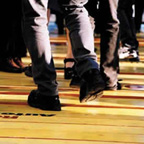
association.creation
Bump--In the project "bump", two wooden bridges in two different cities form the meeting point for large public events. When someone steps on one of these bridges, this person's weight triggers an impulse that is transmitted through a data transmission cable to the wooden bridge in the other city, thus moving the corresponding plank by a few centimeters.
A tactile interface versus the disembodiedness of network worlds.
Two bridges in public space; the inhabitants of one space cannot see the others, but they can sense them and make contact with them. The deformation of space becomes the interface. The interface is called "bump", is ready for the masses to come. Every pressure exerted causes resistance that comes through on the other side. There is a knock from underneath, the slats rise, power transmission via network - "sensations on the move".
"If you move along a city's compact walls, when you least expect it, you see a open and a different city appears. Then, an instant later, it has already vanished. Perhaps everything lies in knowing what words to speak, what actions to perform, and in what order and rhythm." (Italo Calvino)
"bump" creates a in the urban interface, a place where there is no more solid ground under your feet.
A in the urban surface.
"Now there is knocking from below and the boards rise up. Below is another city, reflecting the same irregularity, linked via data transmission line. What is going on there? Undifferentiated mass movements, a stampede of hundreds of feet at rush hour? What about late at night: two or three pairs of feet. A perceptible rhythm. Perhaps a message? Or just a game? We sense the illusion of proximity: directly below the board which raises up, we presume a force which approximates our own.
But there is only the apparatus, the pneumatic piston, the control valve, the sensor. Closeness is only an illusion; the distance is not abolished. The thin pine board is a wall hundreds of kilometers thick. A casual encounter turns into a lasting irritation of the sense of direction: west is below, below is east. How close can we get together?" (Christian Kühn)
A catwalk - 1.5 by 20 meters - is installed in the public space of each city. If a person steps onto this catwalk their weight triggers an impulse which is transferred to the other city by means of a data-line. There a pneumatic piston raises the corresponding board by a few centimeters. At the same time, the principle of the effect can be grasped through a video conference transmission - and visual contact can be made with the "other side."
How close do we wanna get today?
The free-standing bridge on the street refers to something absent: approaching one another, mutually sensing, sensuously experiencing one another. The Internet has brought us all closer together, yet with all our fascination with incorporeal, virtual space, we must not forget the quality of what is missing when we go into the Internet. The world has become larger for "bump" users. Sensing as an elemental experience gives us a feeling for distance and closeness. Collective experience is the prerequisite for common impressions and imprints in a game with an anonymous opposite. Interaction becomes communication.
Sensations on the move
"The spacelessness and the disembodiedness of the virtual world returns to the sensuous, tactile world, which means that crossing the border of an 'abstract' medium creates a new actionist reality that would be unimaginable in a reality without a virtual opposite. This enables an intensification of the perception that was previously mourned as loss. Perhaps a new medium is born with this virtu - reality? "bump" affords the 'virtual world' a new field of action and the sensuous perception of impulses from previously unimaginable networks." (Friedrich Achleitner)
An intelligent urban fixture, accessible
"The telematic arrangement of "bump" is prototypical for intelligent urban fixtures: beyond the specifically local experience in two cities, the interaction and communication of the people in both places through the telematic furnishing are the prerequisite for experiencing telematic simultaneity." (Gerfried Stocker)
The telematic bridge is imprinted with logos from companies that enable Internet communication. "bump" as an image and a part of the commercialized world in which we live, and which we cannot elude. "bump" as a furnishing of a city that you traverse. "bump" has proven itself as a transparent and functional medium. The many people who have enthusiastically stepped on it call it a sensation that awakens associations and creates connections.
bump: to hit or collide with a jolt, ~ into: fig. to meet someone unexpectedly; swelling, lump, bulge; ~ of locality: sense of direction
1998 BUMP: Opening of the Ars Electronica 99 by the mayors of Linz and Budapest on the bridge
ESTABLISHED in 1997 by: Christian Smretschnig, Michael Bieglmayer, Roland Graf, Werner Schmid.
Technical directors: Christian Troger, Elmar Trojer.
From Ars Electronica website.
Posted by jo at 08:20 AM | Comments (0)
November 04, 2005
Arch-OS
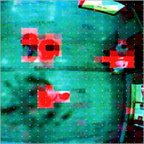
Software for Buildings
Arch-OS constructs a virtual architecture from the activities that take place within the Portland Square Development (Plymouth, UK). This "software for buildings" has been developed to manifest the life of a building and provide artists, engineers and scientists with a tool for developing transdisciplinary work and public art. Embedded technologies capture audio-visual and raw digital data from the building through: • the Building Energy Management System (BEMS) • computer and communications networks • the flow of people and social interactions • ambient noise levels.
This data is then manipulated (using computer simulation, visualisation and audio technologies) and replayed through projection systems incorporated into the architecture and broadcast using streaming internet technologies. Developed by the Institute of Digital Art & Technology. [blogged by Regine on we-make-money-not]
Posted by jo at 11:35 AM | Comments (0)
November 03, 2005
The Hubscape
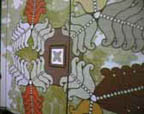
Flooding the Hub with Meaning
Xperception has created an environment where users of the printing hub of the Faculty of Architecture at the University of Sydney can gain a sense of knowledge about the labs and other surrounding areas. They flood the hub with meanings by incorporating an ambient installation, called The Hubscape, with a projection and lighting.
The system was inspired by the Activity Wallpaper Ambient Visualization which presented the users of a public space with information that was relevant to them in the form of a non obtrusive wallpaper. The shape and the intensity of the colours of the Hubscape wallpaper are influenced by factors such as: the timetable/scheduling of the classes, the sound levels, temperature and entropy within each lab but also the current incoming/outgoing network traffic data and the external temperature.
Above each printer the group installed lights. The speed of rotation animation of each light cluster is based on the printer queue size at their corresponding printer. The shorter the queue, the slower the rotation animation, for example. Besides, when a file is sent to one of the printers, its size is a measure of the number of bytes. This is represented in the installation by the relative brightness of the lighting devices.
Sounds a bit complicated, but have a look at their website and it will get much clearer.
The work will be presented at IE2005, Australasian Conference on Interactive Entertainment, 23-25 November 2005, Sydney. [blogged by Regine on we-make-money-not]
Posted by jo at 08:47 AM | Comments (0)
October 07, 2005
CONTAINED

Improvisatory in Nature
Contained--by MIX--is a collaborative and interactive, hybrid work performance/installation that utilizes technology to blur artistic boundaries and challenges notions of presentation/audience. The artists have created a generative, improvising, real-time multimedia environment using both commercial and custom designed software in conjunction with dedicated hardware sensors, motorized robotics and real time processing or text, video, images and sound. Contained is improvisatory in nature, principles of movement improvisation are employed in the creation of the imagery, sound, and movement generated by the system.
October 7, 8, 2005; 7:30pm; Doane Dance Performance Space; Denison University campus, Denison University, Granville, Ohio 43023 USA • 1-800-DENISON; Performance with Artists' Talk to follow.
MIX is:
Sandy Mathern-Smith, dance,
Alexander Mouton, Art,
Micaela de Vivero, Art,
Christian Faur, Art, Digital Technology
Aaron Fuleki, Music, Digital Technology
Marlon Barrios Solano, dance and interactive art
http://www.unstablelandscape.org/
Mary Sykes, Lighting Designer
Posted by jo at 09:40 AM | Comments (0)
October 06, 2005
Playing the Building
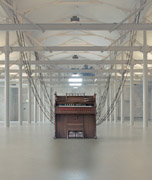
Architecture as Instrument
With Playing the Building, David Byrne wanted to create an installation that would produce sound and would take advantage of the fact it is housed in a raw factory space- with exposed pipes, heating and structural elements.
Devices are attached to the building structure- to the metal beams, the plumbing, the electrical conduits, the heating pipes, the water pipes - and are used to make these things produce sound. No amplification is used, no computer synthesis of sound and there are no speakers. The machines will produce sound through wind, vibration and striking. The devices that are part of the piece do not produce sound on their own, but instead they cause the building elements themselves to vibrate, resonate and oscillate so that the building itself becomes a very large musical instrument.
At the the Färgfabriken artspace, Stockholm, Sweden. 2005-10-08 - 2005-11-13. Opening and party Saturday October 8, 12pm-1am. Related: Sascha blogged the Electromechanical mandala workshop with Douglas Irving Repetto at the UDK in Berln. [blogged by Regine on we-make-money-not-art]
Posted by jo at 10:33 AM | Comments (0)
September 28, 2005
aperture

Facades as Autonomous Skins
aperture--by UDK--is a facade installation with interactive and narrative display modes. Composed of single aperture-modules with receptor and actuator, aperture acts like an autonomous skin, capable of precise external control. Visual information is transmitted from the inside of the building to the outside, the surface permeability is regulated when the aperture‘s opening diameters are changed.
Each single aperture and all the apertures as entity "see" what happens on the inside of the facade and react accordingly: like the human eye‘s iris and the iris diaphragm of the objective, they react to light, widening and contracting according to the intensity of incoming light. If no human activity is to be distinguished on the inside, a "memory" mode recalls images and abstract animations captured throughout the day and displays them.
People standing in front of the wall are exposed to the aperture grid. The duration of the image fading out, as the apertures close, is itself a reflection of how long a person has been standing in front of aperture. Video of the working prototype. A project by Frédéric Eyl and Gunnar Green who are looking for sponsors to further develop the project. [blogged by Regine on we-make-money-not]
Posted by jo at 07:00 AM | Comments (0)
September 25, 2005
trust and shared intimacy

love with technical difficulties
Opened September 22 at Artspace in Sydney Australia, Fish-Bird Circle B-Movement C is an interactive installation by Mari Velonaki exploring human computer interface through interaction with kinetic objects. The Fish-Bird project utilises wheelchairs personifying a fish and a bird that fall in love but can't be together due to "technical difficulties".
Wheelchairs equipped with robotic arms enable fish and bird to communicate through writing. Each wheelchair writes in a distinctive cursive font that reflects its “personality”. The written messages are subdivided into two categories: personal messages communicated between the two robots, and messages written by a robot to a human participant. Personal messages are selected from fragments of love-letters offered by friends, from the poetry of Anna Akhmatova, and from text composed by Velonaki.
The audience internalises the characters through observation of the words and movements that flow between the characters, and between the characters and the audience, in response to audience behaviour. Through movement and text the artwork creates the sense of a person, and allows an audience to experience that person through the perception of what is not present.
Posted by michelle at 12:43 AM | Comments (0)
September 19, 2005
the Space Between the Physical and the Virtual
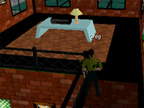
Cognitive Agents in 3D Virtual Worlds
"Abstract: We present an agent-based model of virtual worlds in which the objects in the world have agency, that is, the objects can sense their environment, reason about their goals, and make changes to the environment. The agent-based model has the following reasoning processes: interpretation, hypothesizing, and action activation. This agent model is described and illustrated using a wall agent in a multi-user virtual world. We extend the illustration through a demonstration of a multi-agent world in which many of the objects in the world interactively reason about the use of the world and respond specifically to the people in the world." From Cognitive Agents in 3D Virtual Worlds by ML Maher, JS Gero, G Smith, N Gu, University of Sydney, Australia; International of Design Computing, Vol 6, 2003.
Also: Interfacing Virtual & Physical Spaces through the Body: The C y b e r P R I N T Project

"Abstract: The cyberPRINT is a fully immersive, interactive virtual environment that is being generated in real time based on physiological data readings of a human body. In other words, the cyberPRINT is based on creating interfaces between physical and digital spaces and between biology and information technologies. The cyberPRINT is also an event, wherein a performer is connected to the cyberPRINT generator to create a self-sustaining feedback mechanism. Although the use of the body to electronically drive music and media events is not new, most of these works have paid little or no attention to the potential of interactive 3D virtual environments. Nor have they been so technologically advanced, interdisciplinary intensive (involving Architecture, Choreography, Modern Dance, Music, Bioengineering, Medicine and Computer Science), or architecturally focused as the cyberPRINT.
This project covers a wide and fertile territory that goes from the very technical and design oriented to the very theoretical and interdisciplinary. This paper is intended to (1) expand what has been already published about this project (Bermudez et al 2000a) and (2) establish potential areas for discussion before and after the performance."
1. Introduction: Why a Live Performance?
This paper provides background for the live performance of the cyberPRINT, a real time, physiologic data-driven virtual architecture developed by an interdisciplinary team led by two architects during the past 5 years. The reason for this live performance and demonstration is simple. It is only through performance that we can show the true nature of the cyberPRINT. Such demonstration will also provide empirical proof of the theoretical claims and technological details already published elsewhere (Bermudez et al 2000a). In addition, this version of the cyberPRINT will add some novelties occurred since then (such as a new virtual world, data-driven music in real time, a navigational data-globe). Images of a live performance are shown in Figure 1. [via]
Posted by jo at 11:38 AM | Comments (0)
September 06, 2005
Public Anemone
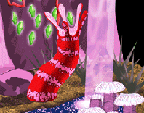
Robot Theatre
Inspired by primitive life, Public Anemone is a robotic creature with an organic appearance and natural quality of movement. By day, Public Anemone is awake and interacts with the waterfall, pond, and other aspects of its surroundings. It interacts with the audience by orienting to their movements using a stereo machine vision system. But if you get too close, it recoils like a rattlesnake.
The anemone starts each day's cycle with a high confidence level and a desire to complete various tasks (such as watering the nearby plants, drinking from the pond, or bathing in the waterfall). It chooses to either continue its tasks or interact with a participant based on their behavior and how much progress it has made with its tasks. If a participant wins the robot's attention, it will respond by orienting toward that person and following their movement.
If a participant gets too close or makes a threatening movement, the anemone may become frightened and recoil from the crowd until it regains its confidence. See Movie (.mov file, 5770 KB). Because the robot makes decisions based on its internal drives and audience interaction, each day is different from the next but follows a coherent theme.
Public Anemone is a collaboration between the Robotic Life and Synthetic Characters research groups at the Media Lab as well as MIT's Artificial Intelligence Lab.
Posted by jo at 10:19 AM | Comments (0)
September 02, 2005
Bondage
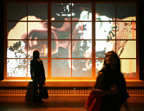
Bound by Pixels
Bondage creates music using pictures of Japanese women made by Japanese photographer, Nobuyoshi Araki. The photo was scanned and projected onto a shoji – the traditional Japanese rice paper wall with sliding doors. The photographs are fed into an image-synthesizing program, scanned and analyzed to become the harmonic spectrum of the sound to be arranged and mixed. Visitors reveal hidden layers of photographs that are projected onto a paper surface. With their movements in front of the installation, they scan the image and modify it, which simultaneously activate the installation’s sound environment. Created by Atau Tanaka. Metasynth processing by Eric Wenger. [blogged by Regine on we-make-money-not]
Posted by jo at 08:42 AM | Comments (0)
August 30, 2005
Screen-Wall
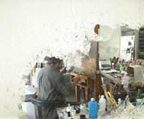
When Bricks Become Pixels
"When bricks become pixels, the tectonics of architecture becomes informational"- Marcos Novak: Screen-Wall--by Ruth Ron--challenges the conventions of public and private spaces in a museum. The 'service' or 'private' parts of the museum, such as the archives, offices or the guard booth, which are traditionally closed to the public, become the subject of the display, reversing the relationship of 'watching' and 'being watched'. Influenced by the expending presence of surveillance in our daily life, we appropriate the panoptic gaze onto concealed parts of the museum to become the content of the exhibition display.
The opaque solidity of physical architecture is challenged by multiple layers of the screen, the image of the wall and the transition to live video feed. The distance between remote spaces in the museum collapses, and digital and visual continuity is created. The network portal extends beyond the properties of the flat digital screen to become a reactive 'window' to unexpected places.
System: Parts of the gallery walls are replaced by small flat monitors. At first, the screens perform as mute, still images of their supporting walls. Once an observer draws near, the image transforms into a live video feed of a remote 'service' location of the museum, streaming via the internet. [via]
Posted by jo at 11:43 AM | Comments (0)
August 27, 2005
Obsession
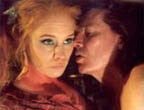
Manuscape: An Instrument for Non-Linear Storytelling
"I have just got back from Helsinki where I saw Pia Tikka's interactive film Obsession at Kiasma Art Museum. This is a four screen work of immense complexity, working with an automated rules-based system of clip selection, influenced by an audience's physiological reactions to what is seen on screen. Swivelling chairs allow the programme to compile data on viewers's gaze direction, while an interactive handprint on the chair arm picks up subtle alterations in skin conductivity and pulse rate and augments the presentation of image according to arousal states. The subject of the film is sexual obsession and attitudes to rape-conflating female desires and fantasies with a semi-documentary narrative. This is an innovative work, using aspects of audience mobility and biology to alter content." [blogged by Martin Rieser on Mobile Audience]
Obsession (2003-), Finland
Project URL: http://crucible.uiah.fi/crunet.nsf/etofilmpages/obsessio
Actor: Media Lab / University of Art and Design
People: Pia Tikka, Rasmus Vuori
Genre: interactive film/ installation and research project
Obsession is an interactive film/ installation and research project by film director Pia Tikka which uses motion sensors, cinematic metadata and generative algorithms. The participant has control over the drama flow in a manner that respects the affective nature of the cinematic media, where the participant may even lose conscious control over the flow of the events. Both conscious actions and unconscious sensorimotor reactions of the participant‘s mind/body can have effect on the narrative. Analyzed images are assigned a position in the narrative story-world map, i.e. the manuscape. The manuscape works as an instrument for non-linear storytelling and allows development of a range of interactive multimedia applications. Interaction and software design by Rasmus Vuori.
From the project web site:
Obsession is an attempt to describe, how the traumatic acts of violence not only affect the individual, but how his or her family and the life-environment are also violated. The narrative level of Obsession, in regard to its subject matter of "sex and violence" in our representational culture, brings this important subject matter to the focus of discussion. Inside the four walls of a self-service launderette, young Emmi and an entrant stranger, Henrik, measure embodied distance. From their interaction, a loaded emotional situation emerges, framed by a trauma that Emmi and Emmi’s mother Jatta share. The distorted mind of Emmi creates an endlessly wandering path of narrative potentialities and interpretations.
The computational core of Obsession is a narrative engine, based on content metadata. Inspired by the Russian film theorist Sergei Eisenstein (1898-1948), the”montage-machine” of Obsession maps spectators’ psycho-physiological states to cinematic elements. Obsession is a kind of enactive cinema: How the narrative unfolds, and how rhythm and soundscape are formed, depend on how the spectator lives by the emotional dynamics between the characters.
Posted by jo at 01:03 PM | Comments (0)
wave_scan

Allegorical Mapping of the Liminal
wave_scan, by Brad Todd, is composed of an ELF (extremely low frequency) sensor, an antenna and a projection of a video database of water filmed over the past 15 years in different countries.
The system is centred around the ELF sensor. In paranormal research these electric and magnetic fields are also monitored by people searching for ghosts and other inexplicable phenomena: "cold spots" and other signs of paranormal activity reported by persons who think they are seeing phantoms are in fact closely tied to these EMF fields.
The ELF sensor is attached to an old TV antenna and is transmitting to a computer. Any detection of weak fluctuations of frequencies near the antenna results in the direct manipulation of a soundscape which is generated using a sine wave and white noise to create synthetic oceanic sounds. Any readings are also translated as clicks and pops, thereby creating a minimialist audio environment which gives audible evidence of a "presence" in the space.
Besides, the image slowly works itself from full chroma to blank, depending on the number of "hits" in the space. This sense of effacing the work and rendering the image into a ghostly and finally invisible screen closes a circuit or cycle of the works "life", in an allegorical mapping of our anxiety concerning the unseen or liminal... [blogged by Regine on we-make-money-not]
Posted by jo at 09:15 AM | Comments (0)
August 26, 2005
Residual Data-Cloud
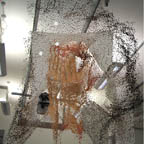
Residual Memory Immersed, Materialized in a Real Environment
The Residual Data-Cloud--by Diogo Terroso--is an application that loads images from a networked source and generates a data-driven three-dimensional form. Images are collected via a digital camera, or a mobile phone, by the author and participants during presentation. The resulting shape, which resembles a cloud of dust, is a metaphor of residual memory immersed and somehow materialized in a real environment.
Digital appears here as a parallel dimension, in which user’s perception is subjected to layers of abstraction and figuration. Its behaviour in the real space, captured by a tracking device, affects data display by revealing different properties of the cloud. Recognizable shapes appear and disappear through interaction. Movie.
Posted by jo at 10:26 AM | Comments (0)
August 22, 2005
Ambient Computing and the Disappearing Computer
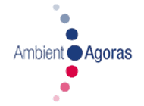
Dynamic Information Clouds in a Hybrid World
"ABSTRACT: There are three parts of my presentation. It starts with a review of (a) previously developed concept of cooperative buildings and Roomware® components as a new approach for designing the work environments of the future and its first example i-LAND. This is followed by presenting the EU-funded proactive intiative "The Disappearing Computer" (DC), a cluster of 17 related projects designing new people-friendly environments in which the "computer-as-we-know-it" has no role. Finally, a specific example of DC-intiative is presented, the project "Ambient Agoras: Dynamic Information Clouds in a Hybrid World." Here, we move beyond the more productivity-oriented support as, e.g., in i-LAND to a more experience oriented approach communicating atmospheres of social architectural spaces. Ambient Agoras aims at transforming places into social marketplaces ('agoras') of ideas and information, providing situated services, and feeling of the place ('genius loci') via a combination of ambient displays and mobile devices." From Ambient Computing and the Disappearing Computer by Norbert A. Streitz.
Posted by jo at 11:16 AM | Comments (0)
Masaki Fujihata
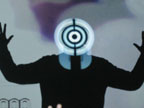
Innovative Public-Led Expedition
bodydataspace (b>d>s) have created a Multi-Media Design Studio with 3-D Exhibition Space for the newly renovated Jaywick Martello Tower. The premiere exhibition for the inaugural opening will be Mersea Circles by Masaki Fujihata. It is a 3-D interactive installation that emerged from an innovative public-led documentation process in August 2003. Taking place on Mersea Island, just off the Essex coast, some 150 people participated all using DV cameras and GPS. As they explored the terrain and its people they captured, with position data, their discoveries and experiences of the landscape, talks and interviews. From the myriad of data gathered, internationally renowned artist, Masaki Fujihata created his latest work.
In addition to the above exhibition, the event on Saturday, 17th September will include a live performance of Soft Ices by artist Mark Storor and composer Jules Maxwell at 3pm. There will also be a site-specific exhibition from the photographer John Kippin.
[b>d>s] is a design unit that delivers artist-led projects into architectural applications and uses interactive technologies to enable people to learn, develop and extend within intelligent data spaces, ultimately enabling the public to have a direct impact on the content of the space they inhabit. It combines the specialist knowledge and creative direction of its founders Ghislaine Boddington (body technology artist) and Armand Terruli (architect/video artist) in a unique collaboration that explores the artistic and technical opportunities present in the fusion of body, data, and space.
Masaki Fujihata / Mersea Circles / COAST: Masaki Fujihata is one of nine artists who have produced artworks for COAST, Essex County County’s ambitious art project celebrating the Essex coast. Mersea Circles is housed permanently at the Jaywick Martello Tower as well as the Ars Electronica Museum in Linz.
Saturday, 17th September 2005
12.30-3pm (invite only)
3-6pm (open to public)
Jaywick Martello Tower, Jaywick,
Clacton-On-Sea, Essex CO15 2LF
Entrance is FREE
Jaywick Martello Tower is the latest digital arts venue to open in the UK and one of the most unusual. This heritage project has transformed the Napoleonic tower’s first floor into a state-of-the-art environment where b>d>s have created a multi-media studio for exhibitions, events and workshops. It includes a floor to ceiling curved projection screen for immersive three-dimensional and audio-visual installations. This unique tower will act as a national resource for commissioning and presenting digital art from regional, national and well-known international artists.
The venue is the accomplished result of a 3-year collaborative venture between Essex Council, Bishops Park College and bodydataspace bringing together the arts, community and education. The Jaywick Martello Tower is managed by Bishops Park College, one of the brand new pioneering schools built under the Labour Government.
DIGITAL ARTS VENUE OPENS
Saturday, 17th September 2005
12.30-3pm (invite only)
3-6pm (open to public)
Jaywick Martello Tower, Jaywick,
Clacton-On-Sea, Essex CO15 2LF
bodydataspace (b>d>s) have created a Multi-Media Design Studio with 3-D Exhibition Space for the newly renovated Jaywick Martello Tower, featuring the work of international Japanese artist Masaki Fujihata.
Jaywick Martello Tower is the latest digital arts venue to open in the UK and one of the most unusual. This heritage project has transformed the Napoleonic tower’s first floor into a state-of-the-art environment where b>d>s have created a multi-media studio for exhibitions, events and workshops. It includes a floor to ceiling curved projection screen for immersive three-dimensional and audio-visual installations. This unique tower will act as a national resource for commissioning and presenting digital art from regional, national and well-known international artists.
The venue is the accomplished result of a 3-year collaborative venture between Essex Council, Bishops Park College and bodydataspace bringing together the arts, community and education. The Jaywick Martello Tower is managed by Bishops Park College, one of the brand new pioneering schools built under the Labour Government.
The premiere exhibition for the inaugural opening will be Mersea Circles by Masaki Fujihata. It is a 3-D interactive installation that emerged from an innovative public-led documentation process in August 2003. Taking place on Mersea Island, just off the Essex coast, some 150 people participated all using DV cameras and GPS. As they explored the terrain and its people they captured, with position data, their discoveries and experiences of the landscape, talks and interviews. From the myriad of data gathered, internationally renowned artist, Masaki Fujihata created his latest work.
In addition to the above exhibition, the event on Saturday, 17th September will include a live performance of Soft Ices by artist Mark Storor and composer Jules Maxwell at 3pm. There will also be a site-specific exhibition from the photographer John Kippin.
Entrance is FREE.
For b>d>s Press Invites, additional INFO and IMAGES contact Jamie McLaren:
Tel: 07949 111 871 or 020 7357 0823 / Email: jamie@bodydataspace.net
Partners of the renovation project include Essex County Council, the Heritage Lottery Fund, European Union through the Intereg IIIB programme, English Heritage, the Essex Rural Renaissance Fund, Essex Environment Trust, Park Resorts, EEDA and Tendering District Council.
NOTES TO EDITORS:
bodydataspace
b>d>s is a design unit that delivers artist-led projects into architectural applications and uses interactive technologies to enable people to learn, develop and extend within intelligent data spaces, ultimately enabling the public to have a direct impact on the content of the space they inhabit.
b>d>s combines the specialist knowledge and creative direction of its founders Ghislaine Boddington (body technology artist) and Armand Terruli (architect / video artist) in a unique collaboration that explores the artistic and technical opportunities present in the fusion of body, data, and space.
Masaki Fujihata / Mersea Circles / COAST
Masaki Fujihata is one of nine artists who have produced artworks for ‘COAST’, Essex County County’s ambitious art project celebrating the Essex coast. To find out more about the COAST project go to http://www.coastart.org
Mersea Circles is housed permanently at the Jaywick Martello Tower as well as the Ars Electronica Museum in Linz.
Managed by the local secondary school, Bishops Park College, it is planned that the Jaywick Martello Tower will be a catalyst for change, developing digital vocational skills. It will provide inspiration for the local community and attract interest and visitors from around the country and overseas to this unique location.
The site provides public access during the summer for environmental and historical groups, schools, tourists, walkers and visitors from overseas.
A permanent on the ground floor for a series of specially-commissioned permanent artworks by artist John Kippin on the theme of Essex coastal landscapes and the history of its military installations, linked with sites abroad.
A base for community arts projects with links to local schools.
Observation facilities on the on the roof, including a purpose-built look-out station, to be used by the National Coastwatch Institute (NCI). Visitors will also be able to use this facility.
The National Coastwatch Institute is a charity run by volunteers (principally retired people), who provide a visual watch to back up HM Coastguard.
European Interreg is a trans-European body which supports and finances international cross-border projects to achieve balanced regional development.
For information on the centre including the performance event Soft Ices and the work of John Kippin, contact: Keith Watson, Digital Arts Development Officer (c/o Bishops Park College):
Tel: 07802 748 484 / Email: mailto:keith@deluxe-arts.org.uk
Bishops Park College is not so much a school in the community but the community in a school with public library, family support day centre, cyber café, early year’s office and a purpose built neighbourhood nursery. The idea of community was a guiding principle in the overall design of the school, funded by the Private Finance Initiative.
The Head Teacher is Mike Davies.
LINK to Guardian Unlimited Feature on Bishops Park College: http://education.guardian.co.uk/egweekly/story/0,5500,1510479,00.html
Posted by jo at 09:14 AM | Comments (0)
August 17, 2005
R&Sie(n)’s Dandy & Mutant A-life Architecture

I’ve heard about…©
R&Sie(n)’s Dandy & Mutant A-life Architecture by Joseph Nechvatal: R&Sie(n)’s exhibition “I’ve heard about…©” opened on the 6th of July at the Musee d’Art Moderne de la Ville de Paris‘s temporary space at the Couvent des Cordeliers - and I think it is one of the most relevant exhibitions to what is going on in art today that is of importance. R&Sie(n) is an investigational architectural firm consisting of François Roche, Stéphanie Lavaux, and Jean Navarro; working here with Benoît Durandin. Together, they utilize generative heterogeneous mutations in the creation of proposed utopian city spaces. In fact what they propose at the Musee d’Art Moderne is the artificial growing of extruded urban housing (generative & robotic) - where new cities are constructed via robotic processes by feeding off the carcasses of older dying cities. Very viral. Envisioned is an approach to city planning based on growth scripts and open algorithmic procedures. Towards these ends the show itself includes some subtle audio tracts, model-sculptures, a fully immersive hypnosis chamber with video monitors, booking services, 3D movies and robotic drawings/plans that reveal the source code of the generative program at the heart of their work.
There is a definite tangled and intertwined approach to the city vector that reminds me of the dithyrambic visual hyper-logic which has manifested in all modes of decadent artistic periods; from the Hellenistic and Flamboyant Gothic, to the Mannerist, Rococo, and Fin-de-Siècle - as they all opposed dogmatically imposed ocular paradigms with hyper-engendering strategies of form. The multiplicity of its interwoven experiences challenges the now bogus idea of simplicity – a modernist-minimalist idea which has taken on the intensity of a righteous injunction in many cities where the implied equation between simplicity, surveillance and goodness obscures a less evident function: that of cognitive constraint. Such constraint runs counter to what Georges Bataille considered to be the non-hypocritical human condition, which he took as being roused non-productive expenditure (threshold excess) entangled with exhilaration. For the finest comprehensive overview of Bataille's thought in this regard, see his book Eroticism - but also Denis Hollier's book on Bataille's general postulates, Against Architecture.
Given the organic-like, biomorphic architectural forms R&Sie(n) spawn by their generative program, I could not avoid thinking about the Palais Idéal of Ferdinand Cheval (1836-1924) - which to my eyes appeared to be one huge budding edifice when I visited it a few years ago - as if the stupendous mannerist grotto-façade at villa Borromeo had been left to grow untrimmed and run amok. However, the Palais Idéal was constructed by the postman Cheval alone and by hand in the Hauterives (Drôme) (near Lyon) between the years 1879 and 1912; the result of 93,000 man hours of hard labour. R&Sie(n) rightly prefers the work to be accomplished through a computer programmed emergence via artificial intelligence which directs robotic execution. Why should humans physically work when we might better be playing and dreaming?
The other inescapable reference for R&Sie(n)’s work is the visionary city-planning put forth by the Situationists. One thinks immediately of Guy Debord’s essay On Wild Architecture, for example. Like the Situationists, for R&Sie(n), the urban form no longer depends on the arbitrary decisions or control over its emergence exercised by the elite few. Ultimately R&Sie(n) leads us towards juicy Situationist-like complexities and engagements by way of immersion into an open-ended multiplex conceivable as a virtual environment: the Virtual Reality experience.
As R&Sie(n) say themselves, “Many different stimuli have contributed to the emergence of “I’ve heard about…©” and they are continually reloaded. Its existence is inextricably linked to the end of the grand narratives, the objective recognition of climatic changes, a suspicion of all morality (even ecological), to the vibration of social phenomena and the urgent need to renew the democratic mechanisms. Fiction is its reality principle…” Ahhhhh, the domain of decadent art, VR and artifice. Against Nature.
What has been somewhat poorly determined however is the degree a dweller feels totally immersed in an optically excessive space. And this depends to a large extent on personal psychological need and adaptability in accord with the proposed spatial depth cues. Cognitive-aesthetic space has to be coordinated phenomenologically with the proprioceptive space of the eye - and R&Sie(n)’s only failure is in maintaining the evident structural seams of the immersive faux-hypnotic chamber (the only enterable structure and the highlight of the show) because what the entire show is proposing is a seamless immersion into generative totality, and the visual seams take us out of that exquisite fantasy. So they are denied the loveliest of triumphs.
A pity, as one might otherwise imagine oneself totally immersed there somewhat like a 21st Century dandy. As at the birth of the 20th Century, this new hyper-dandy constantly might affirm his or her originality down to the decorative details of the home. In that the robots are doing the algorithmic planning and building, this work definitely proposes a new form of dandyism - if dandyism’s defining characteristic is remembered to be the making of one’s person a work of art while extolling laziness and displaying contempt for work. Evident here are the Baudelairean/Duchampian dandy ideals of impassivity, nonchalance elegance, and inscrutability. What matters are the triumphs of a radical contempt for one’s “hand”.
Indeed one can say that “I’ve heard about…©” favorably extolled artificiality, indifference, impassiveness - the reign of an ironic causality and knotted ambivalence, while staying open to all transactions. Most importantly, a-life forms are embedded within it and its growth is artificial and synthetic. So R&Sie(n) maintains a version of transcendental phenomenological idealism, but they do not disavow the extant actuality of the material sphere. Instead they seek to elucidate the sense of the world-as-is today - that is viractualized – by stressing the embodied nature of human and artificial consciousness and bodily existence as the original and originating material premise of sense and signification.
All told, the show is well done – as proposition. However this proposition inevitably turns the mind to the actualized imposing suavity of Antoni Gaudí’s fully realized wavy architectural shapes in Catalonia. Although he did not travel about Europe, Gaudí was aquatinted with fin-de-siècle Belgium/French avant-garde movements because of the intimate relationship between Barcelona and France and with the pre-modernistic movements of Arts and Crafts, Gothic Revival, and Impressionism which were discussed in the intellectual proto-modernist circle which he frequented. But it was Victor Horta's Art Nouveau movement that influenced Gaudí the most, stimulating him to experiment with new materials and new fluid shapes that appear grown. Gaudí's version of Art Nouveau is characterized by an overwhelming proclivity for the organic nature of women, beasts, and plants which he translated into immersive utility.
Antoni Gaudí is a chief exponent of R&Sie(n)-type open algorithmic building procedures precisely with his 1906 building Casa Batlló located at 43, Passeig de Gràcia, Barcelona - noticeable for its organic tactility of bones and shells within, and its external cocked surf façade and chimerical roof. With Casa Batlló, Gaudí accomplished an astute transformation of an existing building, transforming it into an enchanting immersive gesamtkunstwerk as Gaudí thoroughly undertook the design of every single element of the building, from the extravagantly protuberant façade to all aspects of the interior, including the gracefully gnarled furniture. On the exterior Gaudí was able to combine a flamboyantly surging façade (in an ingeniously cool-color orchestration) while maintaining a dialogue with the neighboring Casa Ametller (1900), built by Josep Puig i Cadafalch (1869-1956) four years earlier. Powerful pillars which resemble the substantiality of mammoth elephant legs accost the visitor at street level, protruding into the sidewalk, nigh tripping up an unaware pedestrian. These legs are bordered by a craggy vertebrae-like tier and the wavy façade extends upward between these two biologically evoking forms, culminating at the roof in a gargoylesque humping crescendo. The façade itself, coated in a layer of Montjuïc stone, shimmers seductively under the sun in multifarious chameleon-like colors; fraught with a scattering of small roundish plates resembling fish or reptilian scales. Affixed to this seething mass of swelling construction are a number of small, elegantly curved balconies with oval shaped portholes.
The entire structure feels unsharpened, flowing and smooth in opposition to the street itself on which the arrangement sits, with the exception of a few square windows up top. Even the walls are gently rounded in strained undulation and contraction, as if they too have entered into the oceanic female throws of a fluttering uteral orgasm. The walls appear to be made of a soft, smooth, supple, leathery material and this illusion of softness is carried through by the roundness of the inside forms of the building where one has the feeling of being pleasantly encased in an expanse of hardened dripped honey. Turning, lunging stair railings are met, engulfed and supplemented by softly heaving honey-colored walls and wooden biomorphicly shaped carved doors and irregularly shaped windows. There are no right angled corners or straight lines, which offers an impression of being wrapped up in one continuous fluid wave motion, complimentary with the exterior. By comparison, R&Sie(n) still has a ways to go in achieving a like sensuality of its avant-garde stance. But one only hopes for them an immediate success in doing so.
Credits:
R&Sie(n) = François Roche, Stéphanie Lavaux, and Jean Navarro with Benoît Durandin
With the production and authorship of :
-Berokh Khoshnevis (Contour Crafting Process, USC, LA)
-Francois Roustang (Hypnosis specialist, Paris)
-Chris Delaporte (Film director, 3D effect, Paris)
-Christophe Berdaguer & Marie Pejus (Artist, Marseille)
-Mathieu Lehanneur (Designer, Paris)
-Laurent Genefort (Science Fiction writer, Paris)
-CNRS Grenoble, Laboratoire de Spectrometrie (Nano Particules)
-M/M (Graphic designer, Paris)
-Gilles Schaeffer (mathematicien, Paris)
-Michel Boulcourt (Landscape architect, Paris)
-Alexandra Midal (Author, Paris)
-Matthieu Kavyrchine (Video artist, Paris)
-Sebastien Szczyrk (Sound designer, Paris)
-Alexandre Merlet (Video producer, Paris)
-Stephan Henrich (Architect, Germany)
-Providence (Singer)
Prototype / installation / publishing
-Ufacto, David Toppani (prototype scale 1)
-One Star Press (neighbourhood protocole publishing)
-Christian Hubert Delisle (prototype)
-Thibaut Boyer (installation)
-Jean-Michel Castagné (electronic driver)
Sponsors, partnership
MAM Paris-Musée (F), MUDAM (L), De SINGEL (B), USC (USA), KANAZAWA 21st century museum (J), CNC / Dicream, (F), LAFARGE (F), Materialise (B), Next Limit Technologies (SP), DAPA (F), University of Architecture Innsbruck (OST), New-Territories (F)
Show closes the 9th of October. Musee d’Art Moderne de la Ville de Paris / Couvent des Cordeliers / 15 Rue de l'ecole de Medecine / 75006 / Phone : 0156813321
Images and more info available at: www.mam.paris.fr
Even more info available at: www.new-territories.com
Posted by jo at 08:06 AM | Comments (0)
August 16, 2005
The Crystalpunk Workshop for Soft Architecture
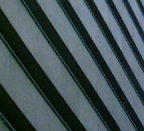
Evolved from Nothingness
September - December 2005, Utrecht, generated by socialfiction.org, hosted by impakt.nl: Hidden in the former utility area of a vacant 13 floor office in Utrecht, the Crystalpunk Workshop for Soft Architecture will evolve an empty room from nothingness into unknown states of technological enhancement. Unlike the alphabet that always knows where it is going, this workshop does not.
A Room of a Crystalpunk's Own: The Headmap manifesto, the Coleridgian masterpiece of independent software development for spaces and places, observed: "Every room has an accessible history, every place has emotional attachments you can open and save". New technologies can associate places with layers of free and editable content from which the past can be re-enacted, like a murder at the scene of the crime is re-enacted, to re-experience and stir vanished memories.
Little minds living in software can eat any piece of data, extract meaning from it and email it to you when the right criteria has been met. Our Crystalpunk Manifesto famously drew connections between disconnected fields of knowledge and explained to the world our intention to program minds and matter simultaneously. This workshop marshals these manifestos of inspiration into real practises with scars of happy absurdi(r)ty engraved on their souls.
Lexicon
Crystal: The inorganic strategies of the crystalpunk are both chemically and metaphorically informed by the lessons learned from the transformation from moleculline mayhem into crystalline order. Crystal growth is adaptive, particle-noise disrupts tessellation but the crystal works its way around it softly. Roomology as crystallography? The analogy with crystals finding form permeates every aspect of this workshop: the room is filled with latent possibility, the workshop seeds these powers laying dormant, what remains after 4 months is outward form pushed and moulded and beaten into shape by events and persons working inside the room with the material produced by their own every moves inside the room.
Punk: Despite appearances this workshop is not technology-driven but propelled forward by social interaction and a healthy disrespect for specialists of all kinds. Punk is not a style or a genre but a principle of self-education: taking up a technology (an electric guitar, a sensor, a programming language) ignoring all good practise, refusing to draw a line between student and teacher. Punks don't spend years practising: they immediately start a band with the intention to change the world.
Workshop: Knowledge is generated collectively, collectives generate their own special flavours of knowledge. This workshop creates a social situation by providing resources to those persons unknown curious enough to come round and actively encourage those people whose past work we like. Different interests, backgrounds, talents, skills will mix, seek alliances and run amok; rapidly the room enhanced starts to generate data, ad-hoc collaborations find challenging ways for this data to be interpreted. Within the workshop countless micro-workshops will focus on specific topics, introducing high-level ideas and technologies to the uninitiated or to keep everybody up to date on the workshop's output, helping each other to make sense of the magic properties of technology. This workshop is a sustained stream of consciousness you can wash your mind/sharpen your capabilities/empower your potential with.
Soft + Architecture: Buildings learn, rooms have memories, design does not need its designers, the language of time (piecemeal extensions, reinventions, rephrasings, accidents, entropy) rewrites their script. A room, by implication, refuses to be belittled into the function of a radio, it wants to be a broadcaster too. Continuous sending information to the world, a room can have a virtual identity and under this guise live a secret life. For instance: a crystalpunk moves his leg for comfort, a crystalpunk shakes her head in disagreement, sensors pick up on it, triggering a wide range of reactions known and unknown, local and faraway. To paraphrase Ezra Pound: in soft architecture each gesture creates content that has form as water poured into a vase has form. Content is recyclable, routed multiple times, finally ending up back where it initiated: causing a sound closing a door illuminating a cryxal on-screen. A crystalpunk walks through the room and, like in a crappy disco, the floor lights up underneath her feet, too bad he is not feeling very much like a dancing queen tonight. Soft Architecture is a home grown architectonic freak show: what the Elephant Man is to the Athletic Body, the Crystalpunk Room will be to the Smart House.
Now that we have found data, what are we going to do with it?!
Technologists have for decades been playing with the idea of the supposedly smart home: the entire house adaptive and responsive and proactive, providing conveniences like that resurfacing dystopian killer-app: the refrigerator that makes sure the milk never runs out. No matter how device-centric and profit-inspired these efforts are, and as such divided by a royal mile from the super-serendipity of Crystalpunk roomology, this workshop is moving in the same problem-space of obvious possibilities and unresolved puzzles of making sense from the surplus of automated data production. Everybody can generate a source of water by opening the tap, few are given to come up with conceptually stimulating ways to process the output.
On Being Soft
Knowledge, so it is said, is the agitator of economic growth, a good education the only insurance against unemployment. Self-education in this respect is a scrapyard challenge: without any experience you can master the use of a jet engine, but when announcing yourself at the job centre it will be back to washing plates or carrying big things if you know what I mean. But self-education is part not of the world of schools and jobs and financial solvency and mortgage opportunities, but an involuntary by-product of the personal creative urge of the kind that start with one innocent question: "what if....?".
What if I make a lot of noise?
From the small but liberating gesture of doing so, its miracle usually diminishing quickly, you may be inspired to find a way forward in a process easily labelled crystalline. Learning to control the machine that makes the noise proposes new questions that need further understanding to be answered. In a different context Sherry Turkle suggested that self-education is rooted in the curiosity in finding out if, by playing around with it, you can make things work for the sake of it. This way to deal with problems, she says, is at odds with the goal oriented alphabetic way of making things as taught at schools. This 'soft mastery' over problems relies in a very real sense on the fact that answers will come to you. A 'lazy' and very unprofessional approach, as you can never explain what you will do beforehand. The Crystalpunk Workshop for Soft Architecture is really entirely very splendidly softly unprofessional indeed.
On Participating
The Crystalpunk Workshop of Soft Architecture workshop lives in 2 distinct spheres: in the corner of a gigantic building in a tiny Dutch city and online where as much realtime roomness is broadcasted as possible. Participation is local, you are invited to bring your laptop and start making noise, to join a workshop or to come listen to a presentation. To those faraway we must mention that, apart from this workshop, there are very few reasons for visiting Utrecht and the more we admire you for doing so. From the deepest Africa you are encouraged to turn yourself into a soft architectonic bootlegger: to render on-line data into representations formal and fluid, in monotones or RGB, spatially exact or rolling like a wave. Or perhaps you are more philosophically inclined and prone to profound reflections, or perhaps breaking things only to rebuild them is the tea you drink: the social infrastructure will be in place to work and think along wherever you are.
We do not care if participants don't know anything useful, and likewise we will welcome you with as much enthusiasm if you do know something useful. We are not like an alphabet but we are neither a cheap bar: we do ask from our participants the desire to unwind their own what-if soft scenarios. If you only want free internet access Beelzebub will bite your head off and create content that has form as a main artery needing urgent medial attention has form.
For a workshop that wants to shake the language and experience of roomness, 4 months is little time, but like with every education, it is never finished A fact learned can reveal itself useful only years after. Come as you are: you can be crystalpunk too.
crystalpunk |at| socialfiction |dot| org
Posted by jo at 09:43 AM | Comments (0)
August 12, 2005
HINGES ON
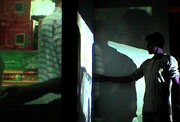
Adaptation, Access, Regulation, Open Source
HINGES ON is an interactive film installation on the informal and formal economies of India's "ICT capital", Bangalore. Visitors enter through a sparsly lit sound tunnel, where they are exposed to an audio experience of failed efforts to retrieve information. (The sound works can be downloaded from the site.) Finally, one is released into the room hosting the video installation. Multiple door-shaped screens in the centre of the space serve as projection surfaces for the four simultanous projections. The screens are on hinges and invite the visitors to turn them into the angel required to catch the projection they wish to watch. (You can find information on the themes and issues in the backdrop section). A switch board provides the interface to the speakers featured on video. (In depth documentation of the process including a list of interviewees and the 'making of switch board, doors and software patches is accessible here!'
HINGES ON at Ars Electronica, opening September 1, 2005, 15:30, Campus / Kunstuniversität Linz. The work was realized by ambientTV.NET during the Tactical Media Lab at Srishti School of Art, Design and Technology, Bangalore, India; with Thomas Abraham, Salam Hidish Singh, Ishan Ghosh, Nishita Kavadia, Siddharth Muthyala, K.T.Thomas, Pratima Kalmadi, Divya Viswanathan, Umang Razdan Bhattacharrya, Ramyah Gowrishankar, and Priyanka Dilip. Lab led by Manu Luksch and Mukul Patel.
Posted by jo at 09:19 AM | Comments (0)
August 10, 2005
Presence

Monitoring the Flow
Presence is a responsive lighting installation that represents the flow of individuals in Parsons School of Design MFA Design +Technology through real-time feedback of activity on the school's 10th Floor. The project consists of two parts: data-gathering through motion detectors and IR sensors distributed in the environment and a light installation, which responds to the signals transmitted from the sensors. The data from sensors influences the dimmers of the light installation, creating optical illusions of colorful shadows in the elevator lobby on 2 West 13th. The effect is also augmented by the subtle changes in mood, generated by the various combinations of cool and warm light.
A sculptural relief wall piece is surrounded by RGB lights, which combine together to create a rainbow of tonalities. Each light is connected to a dimmer which is influenced by the signal received in real time from the sensors. By changing the intensity of the lights, new colors emerge and the perception of the white relief and its shadows is altered, indicating changes in the flow of people converging on the Design and Technology floor. Developed by Mary Behr, Lisa Daly, Ivy Feraco, Margarida Garcia, Maria Ioveva, Ernesto Klar, Gabriela Lopez, Nattapol Suphawong. [blogged by Regine on we-make-money-not]
Posted by jo at 07:47 AM | Comments (0)
August 04, 2005
Hyperfabric
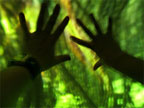
Haptic Magical Mystery Tour
The Hyperfabric fabric-based interface lets you reach beyond the screen. This "touchable" touchscreen, made out of an elastic latex-like fabric warps like rubber, and can sense how hard your press it, where you press it, even when several people use it at once. It feels like you are going "through" the screen.
You can press, grab, twist, punch and play with the screen. It can even support your full bodyweight. The Hyperfabric screen is specially designed to communicate with a computer to generate interactive computer graphics, in realtime.
Adam Montandon and the team at HMC MediaLab created a 7 feet high Hyperfabric installation for the Artytechs parlour this summer at the Port Eliot literature festival. Taking place in a hidden dungeon underneath the stately home, visitors had the chance to come face to face with the magical and mysterious interactions. [blogged by Regine on we-make-money-not]
Posted by jo at 08:28 AM | Comments (0)
July 25, 2005
Mediated Spaces

When Space Understands and Participates
"...The emerging relationship between people and pervasive computation is sometimes idealized as a "smart space": the seamless integration of people, computation, and physical reality. This paper focuses on a particular kind of smart space, the "mediated space," in which the space understands and participates in multiperson interaction. Mediated spaces will expand human capability by providing information management within a context associated with that space. The context will be created by recording interaction within the space and by importing information from the outside. Individuals will interact with the space explicitly in order to retrieve and analyze the information it contains, and implicitly by adding to the context through their speech and gesture. Achieving the vision of mediated spaces will require progress in both behind-the-scenes technology (how devices coordinate their activities) and at-the-interface technology (how the space presents itself to people, and how the space deals with multiperson interaction). This paper explores the research challenges in both of these areas, examining the behind-the-scenes requirements of device or manifestation description and context maintenance, as well as the interface problems of metaphor and understanding natural human-to-human spoken interaction." From Turning Pervasive Computing into Mediated Spaces by W. Mark, IBM Systems Journal.
Posted by jo at 09:51 AM | Comments (0)
July 15, 2005
MIX-m.org
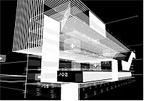
Material and Non-Material Space
MIX-m.org--by fabric | ch--is a mixed space architecture that exists at the same time in variable and complementary spaces: physical space (Contemporary Art Centre Geneva), digital space (a multi-users and game like environment), networked spaces (distributed over the internet). MIX-m.org exists at different scales. Its actual scale depends on the one set as "real" by each user (1:x, 1:50, 1:1, 50:1, x:1). It is basically a 2d-3d architecture project, both real and digital.
Oscillating and hesitating between black and white, between 2d and 3d, MIX-m.org museum echoes some historical archetypes: the "white cube" of modern museum as well as the "black box" of video-art installations. It also echoes some historical "special effects" environments (Tron, before post-processing).
Translated into "screen based" or "beamer based" architecture, this white to black condition becomes an over- to under- enlightened situation. Far from a functional intention, it proposes an evolving illumination system connected to the global activity of MIX-m.org server (rate of information). This system exists both in physical (neon light) and digital spaces (virtual light beam). MIX-m.org as mixed museum becomes therefore a variation between architectural types and references, playing with the user's eye and cultural habits.
Before creating MIX-m.org (3d environments, spatial presence, mobility and lighting concepts, web site), fabric | ch has been exploring contemporary space, within its material and non-material dimensions. The "multiplying space" concept, which underlies MIX-m.org, is the result of such experimental and then applied works: _knowscape mobile (2003-2005), map_I.T. for Swiss Fedral Insitute of Technology (EPFL, 2003) and in particular other "museum" projects, like La_Fabrique (1999-2001), a "3d chat" museum for Canal+, or electroscape 002 (2002), a prototype of MIX-m.org created for MAMCO and Version biennial. See also RealRoom(s).
Posted by jo at 06:25 PM | Comments (0)
June 28, 2005
Tune Me
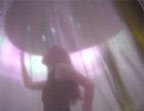
Multi Sensorial Radio
Tune Me is an immersive conceptual radio based upon tactile features. The sound and the visual are triggered by "touchy" interfaces. The visitors enter the ellipse-shaped space, immersing themselves in a new world where to listen to the radio waves.
As well as the sound, each channel provides light features as well as vibrating and pulsing experience. When choosing the different FM stations, the overall space changes, defining different moods upon the nature of the different content. News, sport, classical music and international pop. Each of them triggers a different visual experiences, the space vibrates, pulses and interacts with the visitors.
Developed by Line Ulrika Christiansen, Stefano Mirti and Stefano Testa (with Daniele Mancini and Francesca Sassaroli). More pictures by Stefano and Simone. Also part of Touch Me at The Victoria & Albert Museum (London) till August 29th 2005. [blogged by Regine on we-make-money-not]
Posted by jo at 08:18 AM | Comments (0)
June 20, 2005
Invisible Media
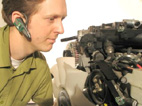
Sensing Focus
Invisible Media: David Merrill and Daniel Schultz are investigating the interaction possibilities that arise when objects in the environment and wearable computers can cooperatively sense the focus of a person's attention. Currently implemented with infrared transceivers, Invisible Media can sense the gaze of the user, while simultaneously communicating their identity. In a learning scenario this two-way ID passing and attention sensing can enable a stateful teaching interaction that tracks the progress of the learner. In a public setting, objects being attended to can transmit the URL of a relevant audio stream or other media to a mobile user. Exciting opportunities for collaborative filtering arise when the number of users and augmented objects gets large.
Posted by jo at 11:07 AM | Comments (0)
4d Pixel
![]()
Direct Human Intervention in Architecture
4d Pixel--by Daan Roosegaarde--is a smart surface which physically reacts to your voice, music and can write relievo letters. The dynamics of the moving wall obeys human interaction, magnet-technology and intelligent software. 4d pixel is about how to create a direct human intervention in architecture, not about electronic circuits or mechanisms... how can space be adaptive to the needs of its users.
4d pixel is being developed as a large façade for a public building and is currently shown at Berlage Institutein Rotterdam, the Netherlands. Related: Reciprocal Space. [blogged by Regine on near near future]
Posted by jo at 10:39 AM | Comments (0)
June 14, 2005
Reciprocal Space
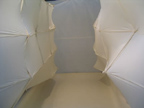
Performed, Experienced, and Felt by Both Sides
Ruairi Glynn has built Reciprocal Space, a physical space that responds to the actions of its inhabitants. The two "Hypersurface" latex walls running in parallel come to life once inhabited, forcing the people to respond and reassess their preconceived ideas of architectural space being fixed.
32 pistons, controlled by a software modify the walls movement according to the visitors' positions. The work will be shown at Submerge, 29th June - 1st July, Bristol UK. Video. [blogged by Regine on near near future]
Posted by jo at 07:53 AM | Comments (0)
